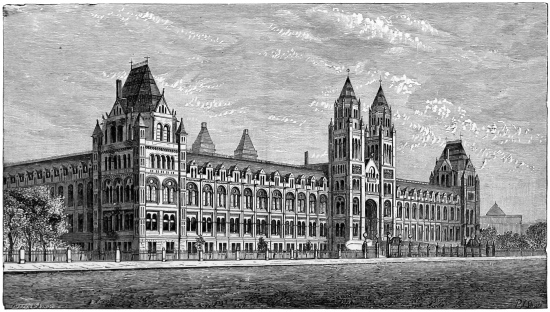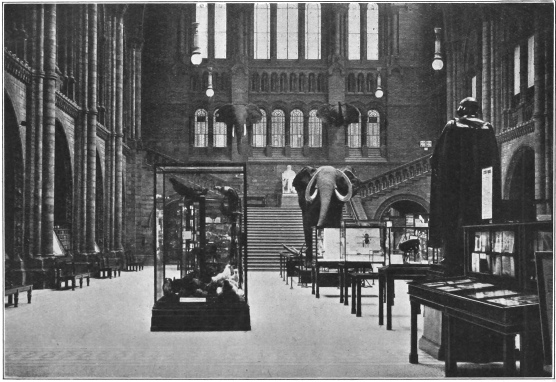GENERAL GUIDE
TO
THE BRITISH MUSEUM
(NATURAL HISTORY).
HISTORICAL SKETCH.
The British Museum dates its foundation from the year 1753, when an Act of Parliament was passed “for the purchase of the Museum or Collection of Sir Hans Sloane, and of the Harleian Collection of Manuscripts, and for providing One General Repository for the better Reception and more convenient Use of the said Collections and of the Cottonian Library and of the Additions thereto.”
Sir Hans Sloane, an eminent physician in London, was for sixteen years President of the Royal College of Physicians, and in 1727 succeeded Sir Isaac Newton in the Presidential Chair of the Royal Society. He was throughout his long life a diligent and miscellaneous collector, having, as stated in the Preamble of the Act of Incorporation of the Museum, “through the course of many years, with great labour and expense, gathered together whatever could be procured, either in our own or foreign countries, that was rare and curious.” His collection, which at the time of his death in 1753 was contained in his residence, the Manor House, Chelsea, consisted of “Books, Manuscripts, Prints, Medals, and Coins, ancient and modern, Seals, Cameos and Intaglios, Precious Stones, Agates, Jaspers, Vessels of Agate and Jasper, Crystals, Mathematical Instruments, Drawings, and Pictures,” and included numerous zoological and geological specimens, as well as an extensive herbarium of dried plants preserved in 333 large folio volumes.
2 According to the terms of Sir Hans Sloane’s will, this collection was purchased for the sum of £20,000—far below its intrinsic value—in order “that it might be preserved and maintained, not only for the inspection and entertainment of the learned and the curious, but for the general use and benefit of the public to all posterity.”
The valuable collection of manuscripts formed by Sir Robert Cotton at the end of the sixteenth and beginning of the seventeenth centuries was already the property of the nation, having been presented by his grandson, Sir John Cotton, in the year 1700. The Harley Collection was obtained by purchase at the same time as the Sloane, and the three were brought together under the designation of “the British Museum,” placed under the care of a body of Trustees,1 and lodged in Montagu House, Bloomsbury, purchased for their reception in 1754. The Museum was opened to the public on the 15th of January, 1759. Admission to the galleries of antiquities and natural history was at first by ticket only after application in writing, and limited to ten persons, for three hours in the day. Instead of being allowed to inspect the cases at their leisure, visitors were conducted through the galleries by officers of the house. The hours of admission were subsequently extended; but it was not until the year 1810 that the Museum was freely accessible to the general public for three days in the week, from ten to four o’clock. The daily opening, with longer hours in summer, dates from 1879.
At the time of the foundation of the Museum, the site allotted seemed amply sufficient for its purposes; but gradually, as the collections increased, they outgrew the limits, not only of the original Montagu House, but even of its successor, the present classical building, completed in 1845 from the designs of Sir Robert Smirke. The erection of the magnificent reading-room in 1857 disposed for a time of the difficulty3 of finding accommodation for the ever-growing library; but the keepers of other departments continued urgent in their demands for more space, and after much discussion of rival plans for keeping the collections together and obtaining the needful extension of room by acquiring the property immediately around the old Museum, or for severing the collections and removing a portion to another building, the latter course was finally decided upon. At a special general meeting of the Trustees, held on the 21st of January, 1860, attended by many members of the Government in their official capacity, a resolution, moved by the First Lord of the Treasury, was carried “That it is expedient that the Natural History Collection be removed from the British Museum, inasmuch as such an arrangement would be attended with considerably less expense than would be incurred by providing a sufficient additional space in immediate contiguity to the present building of the British Museum.”
The House of Commons, in the Session of 1863, sanctioned the purchase of part of the site of the International Exhibition of 1862 at South Kensington, with a view to appropriating it to the purpose of a Museum of Natural History.
In January, 1864, the Commissioners of Her Majesty’s Works issued an advertisement for designs for a Natural History Museum and a Patent Museum, to be erected on part of the land thus acquired; a plan which had been prepared by Mr. Hunt in September, 1862, from Sir Richard Owen’s suggestions, being proposed as a model in respect to dimensions and internal arrangement.
The plans of the various competitors were submitted to Her Majesty’s Commissioners of Works, who awarded prizes to three of the number, giving precedence to that of Captain Francis Fowke, R.E., and then referred the three selected plans to the Trustees of the British Museum. As the internal arrangements in Captain Fowke’s plan did not meet with the approval of the Museum officers, he was desired to modify them in conformity with the requirements of the Trustees, and was engaged in this labour when his death occurred, in September, 1865.
Early in the year 1866, Mr. Alfred Waterhouse was invited by the Chief Commissioner of Works to take up the unfinished work4 of Captain Fowke, but found himself unable to complete the plan to his own satisfaction. In February, 1868, he was accordingly commissioned to form a fresh design, embodying the requirements of the officers of the Natural History Departments of the Museum.
Mr. Waterhouse was not long in submitting to the Trustees his plan and model of the building, with a disposition of galleries as required, and these were formally accepted by the Trustees in April, 1868. It was not, however, until February 1871 that the working plans had been thoroughly considered, and had received the final approval of the Trustees.
The actual work of erection commenced in the year 1873, and the building was handed over to the Trustees of the British Museum by Her Majesty’s Commissioners of Works in the month of June, 1880. As soon as the exhibition-cases were completed, and the galleries sufficiently dry to receive the collections, the labour of removing the Natural History Collection from Bloomsbury was begun. The departments of Geology, Mineralogy, and Botany were arranged in their respective sections of the Museum in the course of the year 1880, and the portion of the Museum which contained these departments was first opened to the public on April 18th, 1881. It was not until the following year that the cases destined to receive the larger collections of the Zoological Department were sufficiently near completion to allow of these collections following, and three more years were required before all the galleries could be brought into a state fitted for public exhibition.
The following description of the structure was contributed by Mr. Waterhouse:—
“The New Natural History Museum will, from its position, always be more or less identified with the International Exhibition of 1862, which occupied the whole of the site between the Horticultural Gardens and Cromwell Road. It was at one time thought that a portion, at any rate, of the Exhibition buildings could with advantage have been converted into a Museum of Natural History. Parliament, however, decided against the preservation of any part of these buildings, and they were accordingly entirely removed.
“In designing the present building, Captain Fowke’s original5 idea of employing terra-cotta was always kept in view, though the blocks were reduced in size, so as to obviate, as far as possible, the objection to the employment of this material, arising from its liability to twist in burning. For this and other reasons the architect abandoned the idea of a Renaissance building, and fell back on the earlier Romanesque style which prevailed largely in Lombardy and the Rhineland from the tenth to the end of the twelfth century.
“In 1873, a contract was entered into by the Government with Messrs. George Baker and Sons, of Lambeth, for the erection of the building at a cost of £352,000. Other subsequent contracts have been entered into by the Treasury, especially one for the erection of the towers, which in the first instance it was decided to omit.
“On looking at the exterior of the building, one of the first points which strikes a spectator is that the site is lower than the street. This arises from the fact that the whole surface of the ground between the three roads was excavated for the Exhibition building of 1862, and it was not thought desirable, for economical considerations, to refill the space. The building is set back 100 feet from the Cromwell Road, and is approached by two inclined planes, curved on plan and supported by arches, forming carriage-ways. Between the two are broad flights of Craigleith stone steps, for the use of those approaching the building on foot. The extreme length of the front is 675 feet, and the height of the towers is 192 feet. The return fronts, east and west, beyond the end pavilions, have not yet been erected.2
“On entering the main portal, the visitor has before him the great central apartment of the Museum (170 feet long, by 97 feet wide, and 72 feet high), which it is intended to use as an Index or Typical Museum. The double arch in the immediate foreground which spans the nave (57 feet wide), carries the staircase from the first to the second floor. Opposite the spectator, at the end6 of the hall, is the first flight of the staircase, 20 feet wide, which rises from the ground to the first floor. The galleries over the side recesses form the connection between the two staircases, and are also intended for exhibition space, as are also the floor of the main hall and the side recesses under the galleries. The arches under the side-flights of the main staircase at the end of the hall lead into another large apartment, with an extreme length of 97 by 77 feet measured into the arms of the cross.
“Branching out of the Central Hall, near its southern extremity, are two long galleries, each 278 feet 6 inches long by 50 feet wide. These galleries are repeated on the first floor, and in a modified form on the second floor. They are divided into bays by coupled piers arranged in two rows down the length of the galleries, and planned in such a manner as to allow of upright cases being placed back to back between the piers and the outer walls, so as to get the best possible light upon the objects displayed in the cases with the least amount of reflection from the glass, and leaving the central space free as a passage. Owing to the nature of the specimens exhibited in one or two of these galleries requiring for their exhibition rather table-cases than wall-cases, advantage has only been taken to a limited extent of this disposition of the plan. These terra-cotta piers, however, are constructively necessary, not only to conceal the iron supports for the floor above, but to prevent these supports being affected in case of fire. Behind these galleries on the ground floor are a series of toplighted galleries, devoted, on the east side to Geology and Palæontology, and on the west to Zoology.
“The towers on the north of the building have each a central smoke-shaft from the heating apparatus, the boilers of which are placed in the basement, immediately between the towers, while the space surrounding the smoke-shafts is used for drawing off the vitiated air from the various galleries contiguous thereto. The front galleries are ventilated into the front towers, which form the crowning feature of the main front. These towers also contain, above the second floor, various rooms for the work of the different departments, and on the topmost storey large cisterns for the purpose of always having at hand a considerable storage of water in case of fire. On the western side of the building, where it is intended that the Zoological collection7 shall be placed, the ornamentation of the terra-cotta (which will be found very varied both within and without the building) has been based exclusively on living organisms. On the east side, where Geology and Palæontology find a home, the terra-cotta ornamentation has been derived from extinct specimens.
“The Museum is the largest, if not, indeed, the only, modern building in which terra-cotta has been exclusively used for external façades and interior wall-surfaces, including all the varied decoration which this involves.”
The gardens on the south, east, and west sides of the Museum are open to the public whenever the Museum itself is open, under certain regulations, posted at the entrance gates.
9
GENERAL ARRANGEMENT.
Natural History is an old term, used to describe the study of all the processes or laws of the Universe, and the results of the action of those processes or laws upon such of its constituent materials as are independent of the agency of man.
It is thus contrasted with the history of Man and his works, and the changes which have been wrought in the World by Man’s intervention.
This distinction afforded a convenient and rational basis for the division of the numerous and multifarious objects which had been collected together in the British Museum at Bloomsbury. When it was decided to effect a separation of the collections, those that were purely the products of what are commonly called “natural” forces were removed to South Kensington, while those showing the effects of Man’s handiwork remained at Bloomsbury. Like most others of the kind, this distinction cannot be applied very rigidly. Such lines of demarcation almost always overlap. For instance, examples of modification of animal or plant structure under Man’s influence legitimately find a place in a Museum of Natural History, especially as they may afford illustrations of the mode of working of natural laws. Prehistoric stone-implements, again, are shown in the Geological Department, in order to illustrate the co-existence of Man with extinct Mammals.
Processes or laws cannot, however, be satisfactorily demonstrated in a museum; therefore such branches of knowledge as deal chiefly with these, as Astronomy, Geology (in the stricter sense of the word), and the experimental sciences, as Physics, Chemistry and Physiology, though essentially belonging to the domain of Natural History, have not found a place in the10 Natural History Museum. It is only the results of the working of these processes or laws, as shown in the modifications of the arrangement of the elementary substances of which the material of the Universe is composed, which can be fully illustrated by specimens admitting of being readily preserved and permanently exhibited in a museum. A Natural History Museum, therefore, in the sense in which the term is now usually understood, is a collection of the various objects, animate and inanimate, found in a state of nature. It will be readily understood that as the study of such objects is one of the principal means by which the laws leading to their formation or arrangement may be traced out, it is of the utmost importance for the progress of those departments of knowledge which the Museum is designed to cultivate, to bring together as full an illustrative series of these objects as possible.
Although the validity of the division of natural objects into inorganic and organic or living has been the subject of some discussion, and although the separation of the latter into vegetable and animal is less absolute than was once supposed, yet for practical purposes, Mineral, Vegetable, and Animal remain the three great divisions or “kingdoms” into which natural bodies are grouped, and this classification has formed the basis of the arrangement of the collections in the Museum.
I. Inorganic substances occur in nature in a gaseous, liquid, or solid form. With few exceptions, it is only in the latter state that they can be conveniently preserved and exhibited in a museum, and it is to such that the term “mineral” is commonly limited. The collection, classification, and exhibition of specimens of this kind is the office of the Mineral Department of the Museum, to which is devoted the large gallery on the first floor of the east wing of the building.
II. The study of the vegetable kingdom, so far as it can be illustrated by preserved specimens, is the province of the Department of Botany, which occupies the upper floor of the east wing.
III. In the same way the animal kingdom belongs to the11 Department of Zoology, from which it has been found necessary to separate an Entomological Department. To these two is assigned the whole of the western wing of the building.
There is, however, a fifth department, which owes its separate existence to a time when the terms Zoology and Botany were limited to the study of the existing forms of animal and plant life, and the extinct or fossil forms were associated with minerals, rather than with their living representatives. This arrangement prevailed in the British Museum until the year 1857. The fossils were then severed from this incongruous connection, and placed in a separate department to which the name of “Geology” was given.3 The result is that there are two distinct zoological and botanical collections in the building, one containing the remains of the animals and plants which lived through successive ages of the world’s history from the earliest dawn of life down to close upon the present time, and the other including those living at the particular period in which we dwell. Notwithstanding the objections which may be urged against this separation, it prevails largely in museums, and (owing to certain conveniences, as well as to the difficulty and expense of rearranging extensive collections and reorganising the staff in charge of them) will probably be retained for some time to come. It should, however, be mentioned that a few specimens illustrating some of the more important extinct forms have been intercalated among the recent Mammals and Reptiles; while, conversely, skeletons and other specimens of recent animals have been introduced among the fossil Vertebrates in the Geological Department. Again, the more important remains of extinct Cetaceans are now shown in the Whale-Room, and some of the specimens of recent Elephants, as well as all the Sea-Cows, in the Geological Department.
Besides the five Departments, into which the collection is divided for the purposes of custody and administration, each of which is under the charge of an officer styled “Keeper”12 and a staff of Assistants, there is a sixth, under the supervision of the Director, and arranged in the Central Hall, some of the specimens in which are intended to serve as an introduction to those exhibited in the others.
Inclusive of the last-named collection, the whole of the specimens contained in the Museum, whether Animal, Vegetable, or Mineral, are arranged in the three following distinct series, as follows:—
I. An Elementary or Introductory Series, by which the study of every group should commence. In this series, limited, so far as the cases in the Central Hall are concerned, to Vertebrated Animals and Botany, the leading features of the structure, and, so far as may be, the development of the various parts of some of the more typical members of each group, are demonstrated in a simple manner, and the terms used in describing and defining them explained by means of illustrative examples. This idea is carried out in the Department of Minerals in a series of cases placed on the north or left-hand side of the gallery containing the rest of the collection.
II. The Exhibited Systematic Series, in which the more important types of animals, plants, or minerals are shown, by means of specimens, arranged in a systematic manner; or one which exhibits, so far as may be, their natural relations to each other. Classification is an important feature in this series, which properly should be so extensive and so arranged as to enable visitors to the Museum, without recourse to assistance from the officials, to find every well-known and markedly distinct type of animal, plant, or mineral, and satisfy themselves about, at least, its external characters. In practice, with the amount of space available, and the resources at the disposal of the authorities, it has, however, been found impracticable to carry out this ideal in anything like its entirety, and in most instances only a selection of specimens is in consequence exhibited.
While the two series above mentioned have for their object the diffusion of scientific knowledge, the next ministers mainly to its advancement, so that between them the twofold object of a National Museum of Natural History is carried out.
13
III. The Reserve or Study Systematic Series contains the exceedingly numerous specimens (in many groups the great bulk of the collection) showing the minute distinctions required for working out the problems of variation according to age, sex, season and locality, for fixing the limits of geographical distribution, or determining the range in geological time: distinctions which, in most cases, can only be appreciated when the specimens are kept under such conditions as to admit of ready and close examination and comparison. It is to this part of the collection that naturalists resort to compare and name the animals and plants collected in exploring expeditions, to work out natural-history problems, and generally to advance the knowledge of science. In fact, these reserve collections, occupying comparatively little space, kept up at relatively small cost, and visited by comparatively few persons, constitute, from a scientific point of view, the most important part of the Museum; for by their means new knowledge is obtained, which, given forth to the world in the form of memoirs and books, is ultimately diffused over a far wider area than that influenced even by the exhibited portions of the Museum. Indeed, without the means of study afforded by the reserve series, the order displayed in the arrangement of the exhibition galleries, and the instruction which may be gleaned from the same, would not be possible.
It is important to bear in mind that if all the specimens required for enlarging the boundaries of knowledge were displayed in the public galleries, so that each could be distinctly seen, a museum many times larger than the present one would not suffice to contain them; the specimens themselves would be inaccessible to those capable of deriving instruction from their examination, while, owing to the effects of exposure to light upon preserved natural objects, many would lose their chief characteristics. This portion of the collection must, in fact, be treated as are the books in a library and used for consultation and reference by accredited students.4
In some parts of the Museum the reserve collections are contained in drawers beneath the cases in which the corresponding exhibited portion is placed. This applies principally to the fossil specimens, the shells, and the minerals.14 The reserve birds and insects have special rooms devoted to them, and the extensive series of reptiles, fishes, and other animals preserved in spirit is kept, for the purpose of safety, in a separate building behind the Museum. In the Botanical Department the reserve collections are kept in the well-known form of an Herbarium, or Hortus siccus.
The great bulk of the specimens being arranged in these three series, supplementary collections for facilitating the study of the distribution of animals and plants in space and in time would be advantageous. The first, constituting a geographical series, might show by illustrative examples the leading characteristics of the fauna and flora of each great region of the earth’s surface; the second, or palæontological series, would give examples of the fossil remains found most abundantly in each formation, arranged so far as may be in chronological order.
The only attempt hitherto made at exhibiting a geographical series in the Museum is the collection of terrestrial and fresh-water vertebrated animals of the British Isles, arranged in the pavilion at the west end of the bird gallery. It would be difficult in the present building to find room for other geographical collections, however interesting and instructive. With regard to palæontological collections, although the specimens in the Department of Geology, so called, are mainly arranged not geologically, or according to stratigraphical position, but according to their natural affinities, yet, in many cases, it has been found convenient to adopt a mixed arrangement, the specimens within each large natural group being classified according to the sequence in age of the strata in which they were buried. Such an arrangement, however, is only applicable to the fossils of a particular region, owing to the difficulties in accurately determining the correspondence in age of formations occurring in distant parts of the earth’s surface; hence a large and varied palæontological collection, such as that of the British Museum, is best arranged in the main upon a systematic or zoological and botanical basis. A limited series showing the more characteristic British rock-formations with their included fossil remains, placed in chronological sequence, is arranged in one of the galleries of the Geological Department.
15
DESCRIPTION OF THE MUSEUM AND ITS CONTENTS.
On entering the Museum, the visitor should bear in mind that the principal front faces the south, so that he will be looking due north, with the east on his right, and the west on his left hand.
It must also not be forgotten that a museum in a state of active growth is continually receiving additions as well as undergoing changes in the arrangement of its contents, and since these often occur faster than new editions of the Guide can be produced, there may be variations in the positions of some of the specimens from those here given.
The Central Hall.
On entering the hall the visitor will notice the bronze statue of the late Sir Richard Owen, K.C.B., Superintendent of the Natural History Departments of the British Museum (1856–1884). It is the work of Mr. T. Brock, R.A., and was placed in the Museum on March 17th, 1897. To the right of this is a marble statue of the late Professor T. H. Huxley, sculptured by Mr. E. Onslow Ford, R.A., which was unveiled on April 28th, 1900. In the first bay on the left is a bust, by Mr. Brock, of the late Sir W. H. Flower, Director of the Natural History Departments of the British Museum from 1884 to 1898. Most of the cases placed on the floor of the hall illustrate general laws or points of interest in natural history which do not come appropriately for illustration within the systematic collections of the departmental series.
One group, in a case near the entrance to the hall, on the right, shows the great variation to which a species may become subject under the influence of domestication, as illustrated by examples of the best-marked breeds of Pigeons, all derived by selection from the wild Rock-Dove (Columba livia), specimens of which are shown at the top of the case.
16
In the corresponding case on the left are further illustrations of the same subject. A pair of red Jungle Fowl (Gallus bankiva, or G. ferrugineus) of India represents the species from which the breeds of Domesticated Fowls are generally considered to have been derived. As examples of extreme modifications in opposite directions produced by selection, are exhibited the Japanese Long-tailed Fowls, in which some of the feathers (tail-coverts) attain a length of nine feet, and specimens of a breed in which the tail is absent. There is also shown a group of Fowls living wild in the woods of the Fiji Islands, which are descendants from domesticated birds introduced in the eighteenth century. A pair of Cochin Fowls is exhibited in the same case to display development in point of size and in the abundance of feathers on the limbs; while a pair of white “Silkies” illustrates a modification of the plumage, accompanied by a rudimentary condition of the tail-feathers. The pair of Coloured Dorkings exemplifies a breed cultivated in England.
A series of Canaries is shown in a case in the archway leading from the east side of the central hall to the north hall, as an example of a late addition to domesticated animals, these birds having been first imported into Europe from the Canary Islands in the early part of the sixteenth century. Specimens are exhibited of the wild birds, and of some of the modifications produced by selection.
A case placed to the north of the one containing Fowls illustrates a remarkable instance of external differences in the two sexes and changes in plumage at different seasons, not under the influence of domestication. The birds in it belong to one species, the Ruff (Pavoncella, or Machetes, pugnax), of which the female is called Reeve; a member of the Plover family (Charadriidæ). In the upper division of the case are shown the eggs, newly-hatched young, and young males and females in the first autumn plumage; as well as adult males and females in winter, when both sexes are exactly alike in colour and distinguishable externally by size alone. The large group occupying the lower part of this case consists of adult birds in the plumage assumed in the breeding time (May and June). In the female the only alteration from the winter state is a darker and richer colouring, but in the17 males there is a special growth of elongated feathers about the head and neck, constituting the “ruff” from which the bird derives its name. In addition to this peculiarity, another, rare among wild animals, may be observed, namely, striking diversity of colour in different individuals. Of the twenty-three specimens shown no two are entirely alike.
Next in order stands a case displaying the variations, according to season and age, in the plumage of the Wild Duck, or Mallard (Anas boscas). The most noticeable feature in the plumage-changes is the assumption in summer by males of an “eclipse-plumage,” resembling the one worn by females at all seasons. At other times the males are more brilliantly coloured than their partners. The eclipse-plumage corresponds to the winter, or non-breeding, dress of other birds which have a seasonal change.
On the same side of the hall follow two cases illustrating the adaptation of the colour of animals to their natural surroundings, by means of which they are rendered less conspicuous to their enemies or their prey. The first contains a specimen of a Mountain or Variable Hare (the common species of the north of Europe), a Stoat, and a Weasel, together with some Willow-Grouse and Ptarmigan, as well as an Arctic Fox, in their summer dresses. All were obtained in Norway, and show the general harmony of their colouring at this season with that of the rocks and plants among which they live. The second case displays examples of the same animals obtained from the same country in winter, when the ground was covered with snow. Such striking changes as these only occur in latitudes and localities where the differences between the general external conditions in the different seasons are extreme, where the snow disappears in summer and remains on the ground during most of the winter. Even some of the species here shown do not habitually turn white in the less severe winters of their southern range, as the Stoat in England and the Variable Hare in Ireland. A few permanent inhabitants of still more northern regions, where the snow remains throughout the year, such as the Polar Bear, Alaskan Bighorn Sheep, Greenland Falcon, and Snowy Owl, retain the white dress throughout the year. The whiteness of these animals must not be confounded with18 albinism, or whiteness occurring in individuals of species normally of a different colour, which is illustrated in a case on the other side of the hall.
The case on the east side of the hall nearest the great staircase contains examples of conformity of general style of colouring to surrounding conditions, as exemplified by some of the commoner Birds, Mammals, and Reptiles of the Egyptian desert, placed on the stones and sand amid which they habitually dwell. The advantage of this colouring in concealing the herbivorous species from their enemies, and in enabling the carnivorous to approach their prey unperceived, is obvious. Many excellent cases of concealment by adaptation to surroundings, especially in eggs and young Birds, may be seen among the groups in the Bird-gallery.
More special modifications for the same purpose are shown in the adjacent bay on the east side of the hall by Insects which closely resemble the objects, such as leaves, twigs, etc., among which they dwell. The close imitation of a dead leaf, presented by the Leaf-Butterfly (Callima inachis), when its wings are closed, could not be surpassed. In a further stage of the same condition, called “Mimicry,” the object resembled, or mimicked, is another living animal, belonging to a different species, family, or even order. The resemblance in these instances is also believed to be for protection, or to be in some way advantageous to the animal in which it occurs. We know, however, so little of the habits and life-history of animals in a state of nature that many of the purposes supposed to be served by particular colours or appearances can only be regarded at present as conjectural. Whatever be the real explanation, the facts shown by the specimens in this bay are very curious, and worthy of careful consideration.
The next case on the east side of the middle of the hall contains a series of specimens illustrating albinism, a condition in which the pigment, or colouring matter, usually present in the skin, hair, or feathers, and giving the characteristic hue, is absent. Individuals in this condition occur among many animals of various kinds, and are called “albinos.” In some of the specimens shown in the case the albinism is complete, but in many it is partial, the absence of colouring matter being19 limited to certain portions of the surface. Other examples of complete or partial albinism are shown in the North Hall.
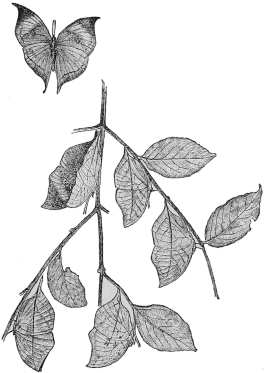
The adjacent case shows examples of the opposite condition called melanism, depending upon an excess of dark colouring matter or pigment in the skin and its appendages, such as hair, feathers, etc., beyond what is commonly met with in the species. This is by no means so frequent as albinism. A black Leopard in the middle of the case is a good illustration. This is not a distinct species, but merely an individual variety of the common Leopard, born from parents of the normal colour. A black Bullfinch is introduced as an example of acquired melanism, this bird having turned black in captivity.
20
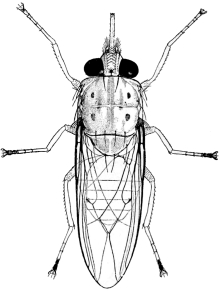
Fig. 2.—The Somali Tsetse-Fly (Glossina longipennis). Enlarged 4 diameters.
Shows the complete closure of the wings in the resting position, and the prominent proboscis, characteristic of the genus.
Another group shows that two forms of Crows which appear quite distinct, and, judged by their external characters, might be regarded as different species, may in a state of nature unite, and produce hybrid offspring. In the same case is exhibited a series of Goldfinches to show a complete gradation between birds of different colouring, which have been regarded as different species. Both these examples may by some naturalists be considered instances, not of the crossing of distinct species, but of “dimorphism,” or the occurrence of a single species in nature in two different phases. From whatever point of view they may be regarded, they illustrate the difficulty of defining and limiting the meaning of the term “species,” of such constant use in natural history.
21
In the middle line of the hall are placed cases containing greatly enlarged models of certain Insects concerned in the spread of disease, such as Mosquitoes or Gnats (figs. 3 and 4), a House-Fly, Tsetse-Fly (fig. 2), and Plague-Flea; also still more enlarged gelatine models of mammalian blood-corpuscles, showing the parasites by which they are infested in the diseases respectively communicated by means of Mosquitoes and Tsetses. Models of the parasites themselves are also shown (figs. 5 and 6).
Malaria, or ague, is a disease caused by extremely minute parasites which live in the red corpuscles of the blood. Formerly malaria was believed to be contracted by merely breathing the air of marshy districts, but it is now proved that the parasites are transmitted from man to man by the “bite,” or rather “stab,” of a Mosquito or Gnat. The Common Mosquito or Stabbing Gnat (Culex pipiens), fig. 3, does not transmit the malaria-parasite; the Spot-winged Mosquitoes (fig. 4) of the genus Anopheles, abundant in England and nearly all parts of the world, being the carriers. The parasite multiplies not only in the human blood, but in the stomach and tissues of the Gnat—as shown in the models (fig. 5).
Tsetse-Flies are African blood-sucking Flies, with the mouth-parts adapted for piercing the skins of wild and domesticated mammals, human beings, and even crocodiles. The blood of some of the larger African animals is sometimes infected with a microscopic parasite (fig. 6), which, if sucked up by Tsetse-Flies when feeding, and subsequently introduced by them into the veins of domesticated animals such as horses and cattle, produces the fatal nagana, or Tsetse-Fly disease. Sleeping-sickness in man is caused in a similar manner, and is conveyed from infected to healthy individuals by two kinds of Tsetse-Fly, including that of which an enlarged model, 28 times (linear) natural size, is exhibited. The parasites and the red blood-corpuscles are enlarged 6,000 diameters.
22
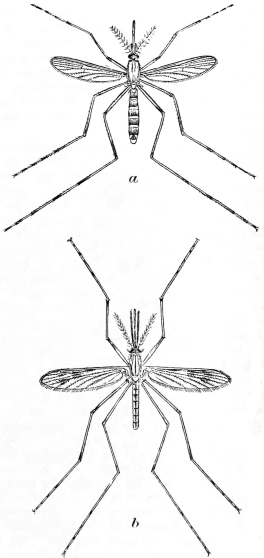
Fig. 3.—(a) The Common Gnat (Culex pipiens). Enlarged.
Fig. 4.—(b) The Spot-winged Mosquito (Anopheles maculipennis). Enlarged.
23
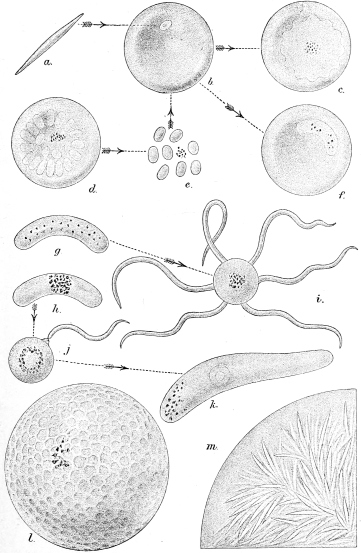
Fig. 5.—Life-History of the Malaria Parasite.
a, malarial germ, or sporozoite, as introduced into the blood by the mosquito; b, sporozoite after entry into blood-corpuscle; c, growth of sporozoite into an amœbula; d, division of amœbula to form merozoites; e, liberated merozoites; f, growth of merozoites into a crescent at expense of corpuscle; g, male, and h, female crescent; i, male cell with projections, which lengthen and are set free as spermatozoa; j, fertilisation of ovum by spermatozoon; k, fertilised egg as the active motile vermicule; sphere formed from the l, enlarged vermicule, after this has bored through the stomach-wall of the mosquito; m, segment of sphere at final stage of development, containing countless needle-shaped spores, which, when it bursts, escape as sporozoites into the organs of the mosquito’s body and pass through the salivary glands into the proboscis, and so infect a man bitten or pricked by the mosquito.
24 The House-Fly—see enlarged models of the perfect insect and its preliminary stages,—although not provided with a piercing proboscis, and consequently incapable of biting, sometimes plays an important part in spreading deadly diseases, such as cholera and enteric (typhoid) fever. In this case the disease-causing organisms are carried by the insect either in its intestine or adherent to the outer surface of its body, and thus House-Flies may spread disease by contaminating food.
Plague, which is a disease of rats and a few other rodents, especially the bobac Marmot, is communicated to man by the bite of the flea known as Xenopsylla cheopis, one of several species of fleas with which rats are infested. When a rat dies, the fleas that it has been harbouring seek another host, and may bite human beings, in which case, if the rat itself was suffering from the disease, an epidemic of plague may be the result. The model of the Plague-Flea exhibited is enlarged 200 times (linear).
The Arachnida, a group which includes the Spiders and can generally be distinguished from Insects by the number of their legs (four pairs instead of three pairs), include also the Ticks, which are responsible for the transmission of many deadly diseases which attack Man and Domestic animals. Enlarged models of a disease-carrying Tick are in course of preparation.
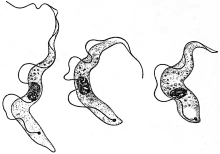
Fig. 6.
Trypanosoma gambiense, the parasite of Sleeping-sickness, very highly magnified. The occurrence of three kinds of individual, as shown in the figure, appears to be characteristic of this and certain other species of Trypanosoma.
(After Col. Sir D. Bruce.)
In the middle line of the hall is placed a magnificent mounted skin of an African Elephant (Elephas africanus), fig. 7, from Rhodesia, standing about 11 feet 4 inches in height. The skull of the same individual is mounted on a stand below. Near by are exhibited three tusks, the largest of which measures 10 feet 2½ inches in length. On the north wall, on either side of the Darwin statue, are mounted two African Elephant heads.
Most of the bays or alcoves round the hall, five on each side, are (with the exception of the one at the north end of25 the right side) devoted to the Introductory or Elementary Collection, designed to illustrate the more important points in the structure of certain types of animal and plant life, and the terms used in describing them. This has been called the “Index Museum,” as it was thought at one time that it would form a sort of epitome or index of the general collections in the galleries. It is now mainly restricted to a display of the leading structural features in Vertebrated Animals and in Plants. The space being limited, the number of specimens is necessarily restricted. In examining this collection the visitor should follow each case in the usual order of reading a book, from left to right, and carefully study the printed explanatory labels, to which the specimens are intended to serve as illustrations.
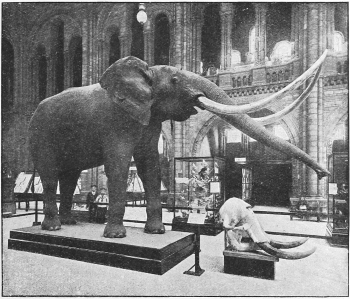
Fig. 7.—African Elephant (Elephas africanus).
The skull and tusks seen in the foreground are those of the stuffed specimen, the tusks in which have been modelled from another individual.
The bays on the west side (left-hand on entering the hall) are26 devoted to the Vertebrata, or Animals possessing a “backbone.” In Nos. I and II are shown the characters of the Mammals, which form the highest modification of this type; the wall-cases of No. I containing specimens of the bony framework (internal skeleton).
In the first case (south side of the recess) may be seen a complete skeleton of a good example of the class—a Baboon Monkey, with the bones laid out on a tablet, and their names affixed. Below is a skeleton of the same animal articulated, or with the bones in their natural relation to each other, and also named. By examining these two specimens an idea may be obtained of the general framework of the bodies of animals of this class. In other parts of the case are exhibited various modifications of the skeleton to suit different conditions of life.
1. Man, showing a skeleton adapted for the upright posture.
2. A Bat, or flying Mammal, in which, by the great elongation of the fingers, the fore-limbs are converted into wings (fig. 8), supporting a web of skin stretched between them.
3. A Sloth, in which the tips of both limbs are reduced to mere hooks, by the aid of which the creature hangs back-downwards from the boughs of the trees among which it passes its entire existence.
4. The Baboon serves as an example of an animal walking on all four limbs in the “plantigrade” position, i.e., with the whole of the palms of the hands and the soles of the feet applied to the ground.
5. A small species of Antelope shows the characteristic form of a running animal, in which the limbs perform no office but that of supporting the body on the ground. This animal stands on the tips of the toes of its elongated, slender feet in the “digitigrade” fashion.
6. A Porpoise, adapted solely for swimming in the water. The fore-limbs are converted into flattened paddles, and the hind-limbs are entirely absent, their function being performed by the tail. The rudimentary pelvic bones are preserved.
The rest of the case is occupied by details of the skull in some of its principal modifications. At the top are diagrams of the structure of bone and cartilage as shown by the microscope.
27
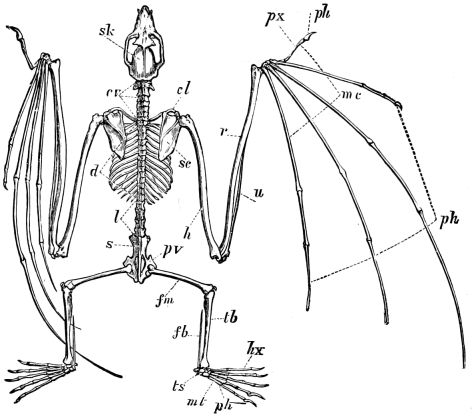
Fig. 8.—The Skeleton of a Flying-Fox, or Fox-Bat (Pteropus medius).
cl, clavicle; cv, cervical vertebræ; d, dorsal vertebræ; fb, fibula; fm, femur; h, humerus; hx, great toe, or hallux; l, lumbar vertebræ; mc, metacarpals; mt, metatarsals; ph, phalanges, or finger- and toe-bones; pv, pelvis; px, thumb, or pollex; r, radius; s, sacral vertebræ; sc, scapula; sk, skull; tb, tibia; ts, tarsus; u, ulna.
In the wall-case on the opposite (north) side of the bay the study of the skeleton of Mammals is continued by illustrations of the structure of the limbs. At the top of the case is a diagram showing the correspondence of the hand and the foot in their complete typical form, with the names applied to the different bones. The series of specimens below shows the principal deviations actually occurring from this typical condition, which, as may be seen, is very nearly preserved in the human hand. One series shows some of the stages of modification for special purpose (specialisation) by which a typical five-fingered hand becomes converted into the single-toed fore-foot of the Horse; while another series ends with the fore-foot of the Ruminants, sometimes, but erroneously, called a “cloven hoof,” in which only two toes remain. Similar changes are shown in the toes of the hind-foot, illustrating the same common plan running through infinite modifications in detail, enabling the28 organ to perform such a variety of purposes, and to exhibit such diversity of outward appearance. The existence of this common plan is now generally regarded as due to inheritance from a common ancestor.
The central case of the bay contains a collection illustrating the principal characters of the teeth of Mammals. Its inspection should commence at the north-east corner, where the visitor will find himself after completing the survey of the specimens of skeletons in the wall-cases. In the first division are placed specimens showing the general characters of teeth, their form, the different tissues of which they are composed, the two great types of dentition in Mammals, homœodont and heterodont,5 the names and serial correspondence of the different teeth, and their development and succession. The principal modifications of teeth according to function are next shown by examples of forms adapted for fish-eating, flesh-eating, insect-eating, grass-eating, etc. The remainder of the case is taken up by examples of the dentition of the families of Mammals arranged in order, and prepared so as to display not only the shape of the crowns, but also the number and character of the roots by which they are implanted.
In bay No. II the two wall-cases contain a collection arranged to show in a serial manner the orders and sub-orders of existing Mammals, by examples selected to illustrate the predominating characters by which these are distinguished. A brief popular account of the characteristics of the group, and a map showing its geographical distribution, are placed with each. This is intended to serve not only for an introduction to the study of the class by visitors to the museum, but also as a guide to a method of arrangement which may be adopted in smaller institutions.
Among the illustrations of the order Primates is placed the skeleton of a young Chimpanzee dissected by Dr. Tyson, which formed the subject of his work on the “Anatomy of a Pigmie,” published in 1699, the earliest scientific description of any Man-like Ape.
29
The central case of this bay contains illustrations of the outer covering or skin and its modifications in the class of Mammals, divided into the following sections:
1. Expansion of skin to aid in locomotion, as the webs between the fingers of swimming and flying animals, the parachutes of flying animals.
2. The development of bony plates in the skin, found among Mammals only in the Armadillos and their allies. The cast of a section of the tail of a gigantic extinct species (Glyptodon) shows a bony external as well as an internal skeleton.
3. The outer covering modified into true scales, much resembling in structure the nails of the human hand. This occurs in only one family of Mammals, the Pangolins, or Manidæ.
4. Hair in various forms, including bristles and spines. The two kinds of hair composing the external clothing of most Mammals, the long, stiffer outer hair, and the short, soft under-fur, are shown by various examples.
5. The special epidermal appendages found in nearly all Mammals on the ends of the fingers and toes, called according to the various forms they assume, nails, claws, or hoofs.
6. The one or two unpaired horns of the Rhinoceroses, shown by sections to consist of a solid mass of hair-like epidermic fibres.
7. The horns of Oxen, Goats, and Antelopes, each consisting of a hollow conical sheath of horn, covering a permanent projection of the frontal bone (the horn-core).
8. The antlers of Deer, forming solid, bony, and generally branched projections, covered during growth with soft hairy skin, and in most cases shed and renewed annually.
On the wall is arranged a series of antlers of an individual Stag or Red Deer (Cervus elaphus), grown and shed (except the last) in thirteen successive years, showing the changes which took place in their size and form, and the development of the branches, or tines, in each year. In old age the number of these tines tends to diminish.
On the north side of the table-case are shown dissections of the principal internal organs of Mammals.
Bay No. III is devoted to the class of Birds. An Albatross (Diomedea exulans) mounted with the wings expanded shows30 the most important characters by which a Bird is externally distinguished from other animals. The body is clothed with feathers, which (in the majority of Birds), by their great size and special arrangement upon the fore-limbs, enable these to act as organs of flight. The mouth is in the form of a horny beak. A nestling Albatross shows that at this stage of its existence the bird is not clothed with ordinary feathers, but with soft down, which serves to keep the body warm, although it confers no power of flight. An Emu and an Apteryx in the lower compartment of the case display the exceptional condition (found only in a comparatively few members of the class) of Birds with wings so small as to be concealed beneath the general feathery covering of the body, and quite useless. In the Penguins, of which two species are shown in the case, the wings are reduced to the condition of fins, and are serviceable only for progress through water.
In the first wall-case the principal features of the skeleton of the class are shown. Sections of bones exhibit the large air-cavities within; a complete skeleton of an Eagle, with the bones separated and named, and mounted skeletons of the Ostrich, Penguin, Pelican, Vulture, Night-Parrot, Fowl, etc., show the chief modifications of the skeleton. The Apteryx possesses the smallest, and the Frigate-bird the longest bones of the wing, the correspondence of which can be readily traced by means of the labels attached to them. The under surfaces of the skulls of various birds are shown with the different bones coloured to indicate their limits and relations; these are followed by a series of the different types of sternum or breast-bone.
The second wall-case contains further illustrations of the anatomy of Birds. In the left-hand part a series of wings of Birds displays the form characteristic of different groups; while above them are a few of the different types of tails, supplementing the series of tails in the table-case. Very instructive is a series of skins of white chickens of the same brood at different ages, displaying the gradual replacement of the down by the adult plumage.
The table-case in the middle of the bay contains illustrations of the external characters, the beak, the feathers, and the tail, as well as of the fore and hind limbs, or wings and feet. By the31 aid of the explanatory labels, the essential characters and the principal modifications of all these parts may easily be followed.
Two cases on the wall in the vestibule leading to the Fish Gallery illustrate the chief modifications of the eggs of Birds, and their differences in structure, number, form, size, texture of surface, and colour. On the side of the main staircase opposite are specimens illustrating the parasitic nesting habits of certain Cuckoos and various other Birds; while near by is a remarkably fine series of the eggs of Cuckoos with those of the Birds among which they were respectively deposited. On the opposite (east) side of the staircase the visitor will find a case showing the remarkable variation in colouring and markings displayed by the eggs of the Guillemot.
The fourth bay on the west side of the hall exhibits the leading peculiarities in the structure of Reptiles and Amphibians. Owing to the large number of groups in the former class now extinct, many fossil specimens, or plaster reproductions of the same, are shown. The wall-case on the south side of this bay illustrates the different ordinal groups of Reptiles—living and extinct. Very instructive are the skeletons of Tortoises and Turtles, showing the relations of the vertebræ and limb-bones to the bony part of the shell. Lizards and Snakes are mostly represented by coloured casts. The extinct Dinosaurs are represented by a small-sized model of Iguanodon, together with a photograph of the skeleton and a plaster-cast of the bones of the hind-foot showing the three toes.
The adjacent side of the table-case shows the modifications of the backbone, or vertebral column, of the ribs, and of the limbs, in the different groups of the class. Specially noticeable are examples of five types of Skink-like Lizards, exhibiting the gradual diminution in the size of the limbs and their final disappearance.
The opposite, or north, side of the table-case displays the different modifications of the skull and teeth of living and extinct Reptiles. In some, like Crocodiles and Ichthyosaurs, the jaws are armed with a full series of sharply pointed teeth, while in others, like the Tortoises and Turtles, they are devoid of teeth and encased in horn. Very remarkable is the32 approximation to a carnivorous mammalian type presented by the dentition of some of the extinct mammal-like Reptiles, or Theromorphs, and equally noticeable are the palatal crushing teeth of certain other extinct Reptiles known as Placodus and Cyamodus. The peculiar dentition of the New Zealand Tuatera, and likewise that of its extinct European and Indian ally Hyperodapedon (fig. 9), are also shown.
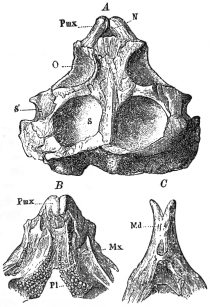
Fig. 9.—Skull of the Giant Tuatera (Hyperodapedon gordoni), from the Triassic Sandstone of Lossiemouth, Elgin, (¼ nat. size). A, upper surface of skull; B, palatal aspect of skull; C, under side of front of lower jaw; Pmx, premaxillary bone; Mx, maxillary; Pl, palatal teeth; Md, lower jaw; O, orbit, or eye-socket; N, nostrils; S, temporal pit; S’, lateral temporal fossa.
The brain and other internal organs of Reptiles are displayed in the left half of the wall-case on the north side of this bay, in which are also shown the eggs of many species, in some cases with the embryo.
33

Fig. 10.—Skeleton of the Great Blue Shark (Carcharodon rondeletii), with portion of backbone on a large scale. pl, functional upper jaw, and su, its reflected portion; md, lower jaw; hy, ceratohyal; br, branchial arches; co, pectoral girdle; ph, cartilaginous portion of pectoral, or front paired fin; r, dermal portion of pectoral fin; pu, pelvic, or hind paired, fin; c, centra, or bodies, of the vertebræ; na, neural, or upper, and ha, hæmal, or lower, arch. The median fins are not lettered.
In the right half of the same case are exhibited a number of preparations showing the external form and internal structure of Frogs and Salamanders, or Amphibians, living and extinct. The Giant Salamander of Japan (Megalobatrachus or Cryptobranchus) is represented by a stuffed specimen; but the Newts, Salamanders, and Frogs are shown in spirit. Very curious is the almost colourless and blind Olm (Proteus) from the caves of Carniola; as also are the so-called Cœcilians, or Apoda, which have the habits and, in some degree, the appearance of large worms. Special specimens exhibit the structure of the extinct Labyrinthodonts, in which the hinder half of the skull is completely roofed over by bone; while34 the teeth in many instances exhibit a curious in-folded arrangement from which the group derives its name.
The last bay (No. V) on the west side of the Central Hall is devoted to the display of the form and structure of Fishes.
The wall-case on the left side of this bay exhibits the external form of several characteristic types of Fishes, such as the Pike, Cod, Turbot, Dog-fish, and Skate, with the names of the various fins affixed. A striking specimen is the skeleton—mainly cartilaginous—of the Great Blue Shark (Carcharodon rondeletii), fig. 10, which occupies the greater portion of this case. It should be noted that, as in all Sharks and Rays, the upper jaw does not correspond with that of the higher Vertebrates; and particular attention should be devoted to the structure and arrangement of the arches supporting the gills.
In the south side of the table-case in this bay are shown a number of dissections, mounted in spirit, displaying the different types of skeletal structure presented by the fins in various groups of Fishes. One of the most remarkable of these types occurs in Ceratodus forsteri, the Queensland Lung-fish, in which the skeleton of the fin consists of a central jointed rod, from each side of which diverge narrower jointed rods. Alongside are specimens showing special modifications of certain fins, as in the Flying Fish (fig. 11) and Flying Gurnard (fig. 12), for the purpose of sustaining the body in the air, or, as in Pentanemus, to serve as organs of touch. Specimens of the West Indian Goby and the Lump-Sucker show modifications of the pelvic fins in connection with a sucker on the lower surface of the body; while other preparations display the pectoral (Doras) and pelvic fins (Monocentris) reduced to the condition of saw-like spines.
The structure of the skull of Fishes is illustrated in another part of the same side of this case. From this the visitor may learn how the primitive cartilaginous skull of the Sharks (fig. 10), Rays, Chimæras, and Lung-fishes has been gradually modified, by the addition of superficial sheathing-bones, into the bony skull of modern Fishes, such as the Cod and Perch.
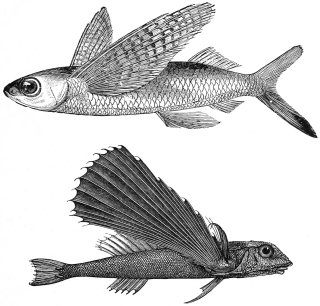
Fig. 11.—The Flying Fish (Exocœtus).
Fig. 12.—The Flying Gurnard (Dactylopterus).
The north side of the table-case in bay V is mainly devoted to the display of the different types of scales, spines, and teeth found among Fishes. In one corner are the enamelled “ganoid”35 scales of the modern American Bony Pike (Lepidosteus) and the African Bichir (Polypterus) alongside those of certain extinct forms. A scale of the Tarpon, or King-of-the-Herrings, illustrates the largest development in point of size of the modern “cycloid” type. Spines of the Porcupine-fish show an extreme development of this kind of structure. Diagrams and spirit-preparations illustrate the mode of attachment and succession of fish-teeth. A large series of the teeth of Sharks and Rays displays the gradual passage from those of the ordinary pointed form to others arranged in a pavement-like manner and adapted solely for crushing. Both types occur in the Port Jackson Shark (fig. 13), but those of some Rays are solely of the pavement modification. Very remarkable is the dental structure in the Parrot-fish. The west end of this side of the case shows the various modifications assumed by the36 teeth of the modern Bony Fishes; among which, as exemplified by the Wrasse, teeth are developed on the bones of the throat, as well as on those of the jaws. Throughout this case specimens, or models, of the teeth of extinct Fishes are placed side by side with those of their nearest living relatives.
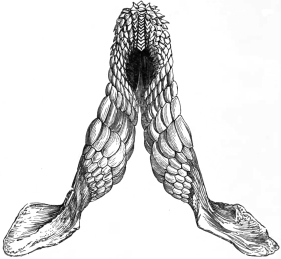
The wall-case on the north side of this bay shows the history of the development of various Fishes, together with the form and structure of the gills, brain, heart, digestive system, and other organs.
A small case affixed to the pillar at the entrance of the fifth bay illustrates the structure of the Lancelet (Branchiostoma, or Amphioxus), by the aid of spirit-specimens, enlarged models, and coloured diagrams. One of the most remarkable features in the structure of this strange and primitive little creature is the outer cavity enclosing the part of the body which contains the large and complex pharynx. The Lancelet was formerly37 included among the Fishes, but is now accorded the rank of a class (Cephalochorda) to itself.
Leaving bay VI, next the principal staircase on the east side of the central hall, which is devoted to illustrations of heredity, especially in relation to the Mendelian theory, and to modes of Flight in Vertebrates and Insects, we pass on to a table-case assigned to the illustration of “Mimicry” and kindred phenomena. Most of the examples shown occur among Insects; but one example among Mammals and a second in Birds are illustrated. Very striking is a coloured sketch showing a group of red and black caterpillars from Singapore grouped side by side on the stem of a plant so as to present a remarkable similarity to a succulent fruit.
In bay VIII, on the eastern side of the central hall, is displayed an exhibition illustrating trees, native to or grown in Britain. The winter and summer states are indicated by photographs, and the foliage, flowers, fruits, seedlings, and texture of wood and bark by specimens, models, and drawings. Bays IX and X are intended to illustrate the general characters of the great groups of the Vegetable Kingdom. Bay IX, in course of arrangement, is devoted to the Cryptogams (Ferns, Mosses, Fungi, Seaweeds, and Lichens).
At the back of the bay is a fine polished section of a buttress from the base of the Tapang (Abauria excelsa), the largest tree in Borneo, which attains a height of 250 feet.
The last bay (No. X) is devoted to the Seed-bearing Plants, which are characterised by the formation of a seed—the result of the fertilisation of an ovule by the male cell which is developed in the pollen. The series begins on the left hand side with the Pteridosperms, an extinct group combining the characters of Ferns and Seed-plants and forming a link between them. Then follow the Gymnosperms (Cycads, Pines, Firs, etc.), in which the seed is borne naked on an open scale which generally forms, with others like it, the characteristic cone. Certain points in the development of pollen and ovule recall similar stages in the Fern group, and indicate that the Gymnosperms stand nearer to the Cryptogams than do the Angiosperms, the other and larger group of Seed-plants. The Gymnosperms are also the older group, and contain many extinct forms. In38 the Angiosperms the seed is enclosed in the fruit, and in the development of pollen and ovule almost all traces of a cryptogamic ancestry have been lost; the great development of the flower is a characteristic feature of the Angiosperms. The arrangement of the vegetative parts of the plant is based on its separation into root, stem, and leaf. In the right-hand wall-case the upper series of specimens illustrates the leaf, its form, veining, direction, the characters of its stalk and stipules, its modification for special purposes, and its arrangement on the stem and in the bud. Below, the stem and root are similarly treated, and above are some anatomical drawings. The display of the root is continued in the lower part of the opposite wall-case. In the central case the chief types of the flower with its parts, the fruit, and the seed are exhibited.
At the back of the bay is a large transverse section of the Karri tree (Eucalyptus diversicolor) of Western Australia, a species which grows to a height of 400 feet. The tree from which the section was cut was about 200 years old when felled.
The Introductory Collection of Minerals will be found in the gallery devoted to the Mineral Department (see p. 90).
The North Hall.
The North Hall, or that portion of the building situated to the northward of the principal staircase, is used for the exhibition of the more important breeds of Domesticated Animals, as well as of examples of Hybrids and other Abnormalities. A series of specimens illustrative of Economic Zoology is likewise temporarily placed here.
The examples of Domesticated Mammals include Horses, Cattle, Sheep, Goats, Llamas, Dogs, Cats, and Rabbits. One of the main objects of this series is to show the leading characteristics of the well-established breeds, both British and foreign. In addition to Domesticated Animals properly so called, there are also exhibited examples of what may be termed Semi-domesticated Animals, such as white or parti-coloured Rats and Mice.
39 The skulls and skeletons of celebrated Horses7 of all breeds, including those of the Thoroughbreds “Persimmon” (presented by His Majesty King Edward VII.), “Stockwell,” “Bend Or,” and “Ormonde,” and of the Shire “Blaisdon Conqueror,” form a notable feature of the series. In another case is exhibited the dentition of the Horse at different periods of existence; while on the opposite side of the same is illustrated the evolution of the Horse from three-toed and four-toed ancestors, and also certain peculiarities distinguishing the skulls of Thoroughbreds and Arabs from those of most other breeds.
Among the more notable exhibits are a mounted specimen of a Spanish Fighting Bull, which belongs to an altogether peculiar breed, and heads of Spanish Draught Cattle, presented by H.M. King Edward VII. Among the Sheep, attention may be directed to the four-horned, fat-tailed, and fat-rumped breeds, and also to the small breed from the island of Soa, as well as the curious spiral horned Wallachian Sheep. The so-called wild cattle of Chillingham Park are included in this series, since they are not truly wild animals, but are descended from a domesticated breed. The celebrated Greyhound “Fullerton” is shown among the series of Dogs, which also comprises examples of the Afghan Greyhound, and of the Slughi or Arab Greyhound. Small-sized models of Cattle, Horses, Sheep, and Pigs also form a feature of the series.
A hybrid between the Zebra and the Ass is shown in one of the cases; while photographs illustrate the results of experiments undertaken by Professor Ewart in cross-breeding between Burchell’s Zebra and the Horse. An example of the Lion-Tiger hybrids born many years ago in Atkins’ menagerie is likewise shown.
A fine series of hybrid Ducks and hybrid Pheasants is exhibited in the north hall.
Facing the visitor as he approaches the middle of the north hall are the skeletons of a Man and of a Horse, arranged for comparison with each other, and also to show the position of the bones of both in relation to the external surface. In the case of the Horse, the skin of the same animal from which the skeleton was prepared was carefully mounted, and, when dry,40 divided in the middle line; one half, lined with velvet, has been placed behind the skeleton. In the case of the Man, the external surface is shown by a papier-maché model, similarly lined and placed in a corresponding position. As all the principal bones of both skeletons have their names attached, a study of this group will not only afford a lesson in comparative anatomy, but be of practical utility to the artist.
Against the wall dividing the north hall from the central hall is placed a section of a very large Wellingtonia or “Big Tree” (Sequoia gigantea), which was cut down in 1892 near Fresno, in California. It is about fifteen feet in diameter, and perfectly sound to the centre, showing distinctly 1,335 rings of annual growth, which afford exact evidence of the age of the tree. An instantaneous photograph, taken while the tree was being felled, is placed near by, and shows its general appearance when living. The height of the tree was 276 feet.
The exhibits of Economic Zoology at present occupy the northern division of this hall. In the western wall-case are specimens showing the injuries caused to trees by various insects. The table-cases contain examples of the damage done in Britain to fruit, roots, corn, and garden and vegetable produce, with specimens of the insects, and hints as to methods of destruction. There are also examples of injury done by insects abroad to cotton, tea, coffee, etc. In the cases under the windows are various parasites affecting man and domesticated animals.
Staircase and Corridors.
On the first landing of the great staircase, facing the centre of the hall, is placed the seated marble statue of Charles Darwin (b. 1809, d. 1882), to whose labours the study of natural history owes so vast an impulse. The statue was executed by Sir J. E. Boehm, R.A., as part of the “Darwin Memorial” raised by public subscription. It was unveiled and placed under the care of the Trustees of the Museum on the 9th of June, 1885, when an address was delivered on behalf of the Memorial Committee by the late Professor Huxley, P.R.S., to which His late Majesty King Edward VII. (then Prince of Wales), as representing the Trustees, replied.
41
Above the first landing the staircase divides into two flights, each leading to one of the corridors which flank the west and east sides of the hall and give access to the galleries of the first floor of the building. Near the southern ends of these corridors two staircases join to form a central flight leading to the second floor. On the landing at the top is a marble statue by Chantrey of Sir Joseph Banks (b. 1743, d. 1820), who for 41 years presided over the Royal Society and was Trustee of the Museum. His botanical collections are preserved in the adjoining gallery, but his library of works on natural history, also bequeathed to the Museum, remains at Bloomsbury, where the statue, erected by public subscription in 1826, stood until it was removed to its present situation in 1886. On the wall above is displayed a series of unusually fine heads of Indian Big Game Animals, bequeathed by Mr. A. O. Hume, C.B., in 1912.
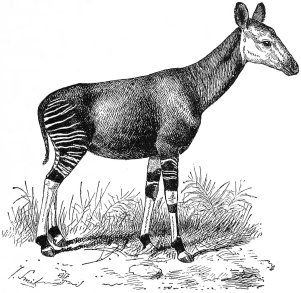
The west, south, and east corridors contain a portion of the collection of mounted Mammals for which there is not room in42 the gallery immediately adjoining. The specimens placed here include a large number of species of the finest African Antelopes, animals remarkable for their beauty, for their former countless numbers, and for their threatened extermination in consequence of the inroads of civilized man into their domain.
In a case at the head of the staircase leading to the east corridor are several mounted specimens of Giraffes, and near by a skeleton of the same. Alongside the former is placed a case containing the heads and necks, together with skulls, of the various local races of Giraffes; while in a third are displayed three specimens of their near ally the Okapi (fig. 14) of the Congo Forest, as well as a skeleton of the same.
The collection of Humming-Birds (Trochilidæ) arranged and mounted by the late Mr. John Gould, and purchased for the Museum in 1881, is principally shown in the vestibule leading from the hall to the Fish-gallery, but a few cases are placed on the pillars of the staircase. Another large collection of these birds, presented in 1913 by Mr. E. J. Balston, of Maidstone, is exhibited in the corridor leading to the Whale-room.
WEST WING.
The whole of the west wing of the building is devoted to the collections of recent Zoology.
(A) Ground Floor.
The ground floor is entered from the west side (left hand) of the central hall, near the main entrance of the building. The long gallery, extending the entire length of the front of the wing as far as the west pavilion, is assigned to the exhibited collection of Birds, the study-series of the same group being kept in cabinets in a room behind.
The wall-cases contain mounted specimens of all the principal genera, placed in systematic order, beginning with the Crows and Birds of Paradise on the left hand on entering, and ending with the Ostriches, Emus, etc., on the right.
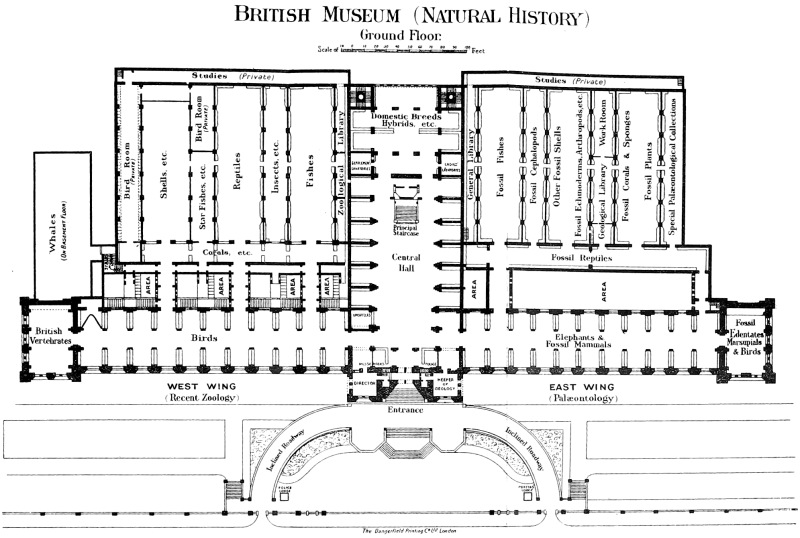
British Museum (Natural History)
Ground Floor.
43
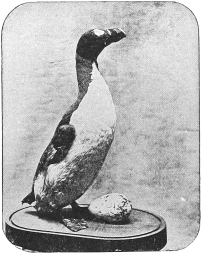
Among the multitude of species exhibited in this gallery, which form, however, but a small proportion of the different kinds of Birds known to inhabit the globe, only a few of the more striking can be mentioned. The various types of the Birds-of-Prey are very fully represented: from the Condor of the Andes, the large Sea-Eagle of Bering Strait, and the Great Eagle-Owl of Europe (all of which are placed in separate cases), to the Dwarf Falcon in case 53, which is not much larger than a sparrow, and preys upon insects. Among the large group of Perching-Birds, attention may be directed to the cases of Birds of Paradise and Bower-Birds in the first bay on the left. In separate cases in the sixth bay on the opposite side of the gallery are placed skeletons of the Dodo and Solitaire, large Pigeon-like birds with wings too small for flight, once inhabiting the islands of Mauritius and Rodriguez, respectively, but now extinct. Other cases on the right-hand side of the gallery are occupied by the Game-Birds, and the Wading and Swimming Birds. Here may be noticed a nearly complete series of the genera of44 Pheasants and Pigeons, showing the various forms. Special attention may be directed to the Great Auk (fig. 15), from the Northern Atlantic, which became extinct only in the last century. Casts of the eggs (fig. 16) of this curious bird are also exhibited. A case in the 7th bay contains a series of Penguins, flightless birds which may be regarded as representing the northern Auks and Guillemots in the southern oceans. Particularly interesting is the great Emperor Penguin, which lays its eggs and rears its young in winter amidst the ice of the Antarctic. Most of the specimens exhibited were obtained during the British Antarctic Expedition of 1839–43, under the command of Captain Sir James Clark Ross.
Other noteworthy types are the Great Bustard, once an inhabitant of England, and the Flamingos; a pair of the latter being exhibited with their nest.
In the first two bays on the right side of the gallery are placed specimens of the Ostrich group, characterised by the flat or raft-like form of the breast-bone. Owing to the rudimentary character of their wings, these Birds lack the power of flight. They include the largest existing Birds, the Ostriches, Emus, and Cassowaries, as well as the small Kiwis (Apteryx) of New Zealand, together with the extinct Moas (Dinornis, etc.), of the same country, and the Roc (Æpyornis) of Madagascar. A fossil egg of the latter is placed alongside eggs of the existing species of the group.
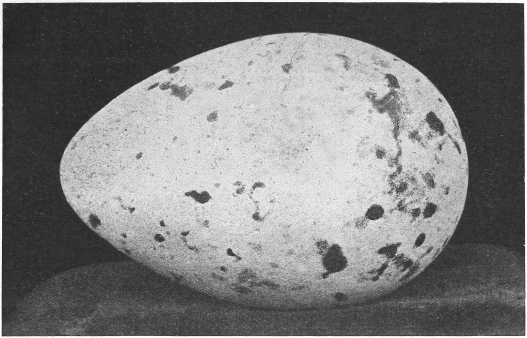
Down the middle line of the gallery, as well as in many of the bays, are placed groups showing the nesting-habits of various species of British birds. The great value of these groups consists in their absolute truthfulness to nature. The surroundings are not selected by chance or from imagination, but in every case are carefully executed reproductions of those that were present round the individual nest. When it has been possible, the actual rocks, trees, or grass, have been preserved, but in cases where these could not be used, they have been accurately modelled from nature. Great care has also been taken in preserving the natural form and characteristic attitudes of the Birds themselves. Among the more attractive cases are, near the centre of the gallery, a pair of Puffins feeding their single young one, and Black-throated Divers with their eggs46 in a hollow in the grass on the edge of a mountain-loch in Sutherland. Hen-harriers—the male grey and the female brown—are shown with their nest among the heather from the moorland of the same county. On the left of these is a Peregrine Falcon’s eyrie, on the ledge of a rocky cliff, containing three white downy nestlings. Near by are various species of Ducks, notably the Red-headed Pochard on the sedgy border of a Norfolk mere. In the last bay but one on the right side is a nest of the Heron, in a fir-tree, with the two old birds and three nearly fledged young. Various species of Gulls and a particularly beautiful group of Arctic Terns from the Shetland Islands are exhibited in the middle line towards the west end of the gallery and in the eighth and ninth bays. In the eighth bay on the right side and in the adjoining passage are Plovers, Sandpipers, Snipes, etc., some of which (especially the Ringed and Kentish Plovers) show the wonderful adaptation of the colouring of the eggs and young birds to their natural surroundings for the purpose of concealment. In the second passage leading to the Coral-gallery are Ptarmigan and Capercaillie from Scotland, and in the adjacent part of the middle line Wood-Pigeons and Turtle-Doves building their simple, flat nests of sticks in ivy-clad trees. In the fourth, sixth and seventh bays on the left are Sand-Martins and Kingfishers, showing, by means of sections of the banks of sand or earth, the form and depth of the hole in which the eggs are placed; and also nests of the Swift, Swallow, and House-Martin, all in portions of human habitations.
The “pavilion” at the west end of the Bird-gallery is devoted to the exhibition of the land and fresh-water Vertebrated Animals of the British Islands. The larger Mammals and Fishes occupy the wall-case on the north side, which is surmounted with horns. In the two pairs of centre cases is exhibited the series of British Birds, supplemented by the groups, to which reference has been made already. The wall-case on the north side of the archway contains a group of Gannets and other sea-birds from the Bass Rock in the Firth of Forth. On the opposite side are two striking groups with the surroundings true to nature, the one of the Golden Eagle and the other of the Buzzard, both taken in Scotland. Other groups in the pavilion display the47 Kestrel, the Peregrine Falcon, and the Merlin amid natural surroundings. Among the Mammals, especial attention may be directed to a case of British Hares and Rabbits. In another case may be seen a female Badger and her young; in a third is a group of Otters; in a fourth a vixen Fox with her cubs; in a fifth a Mole-hill with its inhabitants; in a sixth a pair of Martens; in a seventh Polecats and their young; while other cases are devoted to Stoats, Weasels, Hedgehogs, Squirrels, Rats, Mice, etc.
Here it may be mentioned that the animal inhabitants of any country or district are collectively termed its “fauna.” The British Islands in this respect belong to the great zoological region called Palæarctic, or Eastern Holarctic, embracing all Europe, the north of Africa, and the western and northern portions of Asia. As in the case of other islands, the species belonging to groups in which the power of locomotion is limited to land or fresh-water are not numerous compared with those inhabiting large continental tracts. Their numbers can only increase under exceptional circumstances, and have a tendency to diminish as the growth of human population and increase of the area of cultivated land gradually reduce their native haunts. In this way the Brown Bear, the Wolf, the Beaver, and the Wild Boar have disappeared from Britain within the historic period, while other species, such as the Badger, Marten, and Wild Cat, with difficulty maintain a more or less precarious existence. All these were originally derived from the mainland of Europe, probably before the formation of the channel which now separates it from Great Britain. The wider and older channel which separates Ireland from Great Britain has been a greater barrier to the emigration of animal life than that between the latter and the Continent, many species (as the Polecat, Wild Cat, Mole, Squirrel, Dormouse, Harvest-Mouse, Water-Rat, Short-tailed Field-Mouse, Brown Hare, Roedeer, as well as Snakes and Toads) never having crossed what is now the Irish Sea, unless by human agency.
On the other hand, those species that have the power of travelling through the air or traversing the ocean are far less fixed in their habitat; and it results from this that the list of so-called “British Birds” receives accessions from time to time48 from stragglers which find their way from the European continent or Asia, or even across the Atlantic.
Slight but permanent variations from the continental type may be recognised in many native British species, some of the most marked among vertebrated animals being the Irish Stoat, the Squirrel, the Red Grouse, the St. Kilda Wren, the Coal-Tit, the Goldcrest, and several species of fresh-water fishes, mostly belonging to the genera Salmo and Coregonus. Some of the latter, such as the Vendace, the Gwyniad, and their allies, of which specimens are exhibited in the wall-case in the pavilion, have an extremely local distribution, being found only in certain small groups of mountain lakes.
Of the Seals, only two species are really natives of Britain, the Common Seal (Phoca vitulina) and the great Grey Seal (Halichœrus grypus); specimens of both these are shown in the pavilion.
Those desirous of studying more minutely the characteristics of British Mammals should examine the series of skins and skulls exhibited in a special case on the right side of the central west window.
Parallel with the Bird-gallery, on the north side (right on entering), and approached by several passages, is a long narrow gallery containing the collection of Corals and Sponges and allied types. Commencing at the eastern end, some of the lowest forms of animal life are exhibited in the wall-case and table-cases; they belong to a group called Protozoa, and, for the greater part, are so minute, that they can be studied only with the microscope; their structure is therefore illustrated chiefly by means of models and figures. The next divisions of the gallery are occupied by the Sponges, most conspicuous among these being a series showing the variations of the common Bath-Sponge (cases 1 and 2), the beautiful flinty Venus’ Flower-basket or Euplectella (fig. 17), the Japanese Glass-rope Sponge or Hyalonema (case 3), and the gigantic Neptune’s Cup or Poterion, of which several specimens are placed on separate stands. Special interest attaches to the case showing the different kinds of Sponges used in commerce.
49
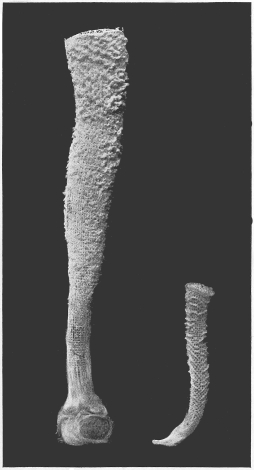
50
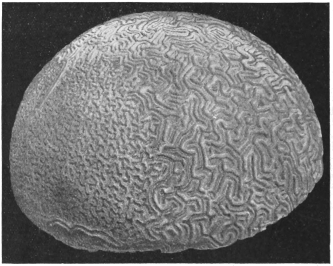
Nearly the whole of the remainder of the gallery is given up to Corals. In life these organisms display an immense variety of form and colour, sometimes presenting a marvellous resemblance to vegetable growths; but the part exhibited in the gallery is merely the dried, hard, horny, or stony basis or supporting skeleton, either of isolated individuals, or of colonies. Corals are allied to the well-known Sea-anemones of the British and other coasts; the combined skeletons of myriads of these animals form the coral-reefs which constitute the bases of thousands of islands in the Indo-Pacific Ocean. Among the larger reef-making species are the Brain-Corals (Meandrina), one of which is shown in figure 18. Near the west end of the gallery is placed a magnificent specimen of the Black Coral of the Mediterranean (Gerardia savalia), obtained off the coast of the island of Eubœa in the Ægean Sea. The drawing in the case shows a magnified view of the “animals” or polyps of this species as they appear in life. In case 13 are specimens and drawings of the Red Coral (Corallium rubrum), so largely used for ornamental purposes,51 and also of the crimson Organ-pipe Coral (Tubipora musica). Arranged on shelves on the south wall of the western end of this gallery is a series of Pennatulidæ (Sea-pens, Sea-rushes, or Sea-ropes) preserved in spirit. These Zoophytes live at the bottom of the sea, with their lower ends fixed in the sand and mud; the skeleton being never more than a straight internal rod in addition to innumerable microscopic spicules.
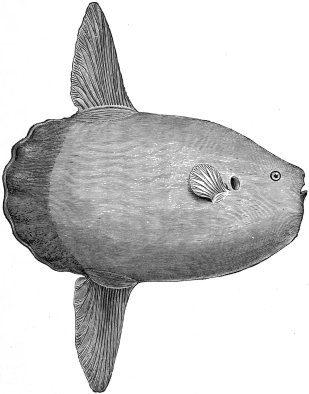
Approached through the Coral-gallery, and running backwards at right angles with it, are several galleries containing other portions of the zoological collections.
52
I. The Fish-gallery is nearest to the central hall, and contains the exhibited portion of the collection of Fishes. The greater number of specimens, preserved in spirit, are, however, placed for safety in a detached building outside the Museum, where they are available for study under special regulations. The gallery contains mounted examples, models, and skeletons of many of the more remarkable members of the class.
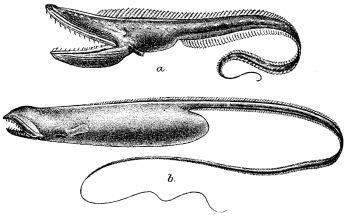

The wall-cases on the east side of the gallery (right on entering) contain the fishes with completely bony skeletons (Teleostei); to which division belong by far the greater part of the species now inhabiting the waters of the globe. Large and53 remarkable examples are placed in separate cases opposite to the wall-cases. As the colours of fishes are very fugitive, and disappear more or less completely after death, most of the mounted examples have been painted. The fishes allied to the Perch, Gurnard, Mackerel, Sword-Fish, Wrasse, Cod, Plaice, Catfish, Salmon, Pike, and Eel are represented by numerous examples. Specially noticeable, so far as size and external form are concerned, are the Sunfishes, Orthagoriscus (fig. 19).
Even more strange are several of the species of deep-sea Fishes exhibited in a table-case in the Fish-gallery, which live at depths where the sun’s rays cannot penetrate, and many of which are self-luminous. Two deep-sea Fishes are shown in the accompanying illustrations (figs. 20 and 21). From another point of view, special attention may be given to the Sucker-Fish or Remora (Echeneis remora), fig. 22, which attaches itself by the sucker on the top of its head to the bodies of Fishes or Turtles, or to the bottom of ships. As it attaches itself back-downwards, the under-parts are coloured dark while the back is light; a condition just the reverse of that obtaining in ordinary Fishes.
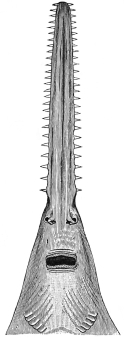
The western or left side of the gallery is devoted to the exhibition of certain very different types of Fishes, which were much more numerously represented in ancient times than at present. The majority have a cartilaginous skeleton. Among these may be specially mentioned the Bichir of the tropical African rivers, the Gar-Pike of North America, the Sturgeons, the Lung-Fishes (Dipnoi) of South America, Africa, and Australia, the Chimæras, and finally the Sharks and Rays. Among the two latter are included the singular Hammer-headed Shark (Zygœna), and the54 Saw-Fishes (Pristis), which have long projecting flattened snouts, with a row of teeth arranged something like those of a saw on each side (fig. 23). A remarkably large specimen from the coast of British Guiana of a species of this group (Pristis perrotteti) is exhibited. Another very small division of Fishes comprises the Lampreys and Hags, of which a few specimens are shown.
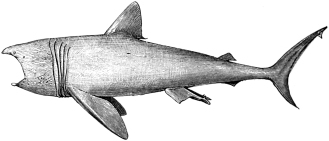
The largest exhibited specimen of the class is the head of a full-grown example of the great Basking Shark (Selache, or Cetorhinus, maxima), fig. 24, captured on the 2nd of March, 1875, near Shanklin, in the Isle of Wight. The length of the entire specimen was twenty-eight feet, but, as the minute size of the teeth indicates, it is a comparatively harmless fish. A smaller female specimen is suspended from the roof; and below this is placed a model of the skeleton of the same species. Near by is a young specimen of another basking species, the Elephant-Shark (Rhinodon typicus), which when adult is said to attain a length of at least fifty feet. It inhabits the Indian and Pacific Oceans.
Models of some of the more remarkable types of extinct Fishes are exhibited in cases on the same side of the gallery.
II. A small gallery is devoted to the group of Arthropoda or Invertebrate animals with jointed limbs, such as Lobsters, Crabs, Spiders, Centipedes, and Insects.
At the south end of this gallery are exhibited specimens of Crabs and Lobsters. Among the former, special attention may be directed to the specimens of the Giant Crab (Macrocheira) of55 Japan, and also to the Coconut Crab (Birgus latro), fig. 25, which climbs trees to feed on young cocoanuts, and is related to the Hermit-Crabs. In the central table-cases, besides Crustacea (Crabs, Lobsters, etc.), are displayed representative Scorpions and Spiders, including several examples of the large Bird-eating Spiders of South America.
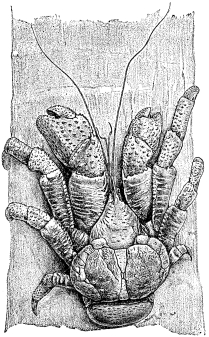
The northern half of this gallery is devoted to the exhibited series of Insects. Next to the door on the east side are the nests of White Ants or Termites, while on the opposite side are some remarkable cocoons of social Caterpillars of various Moths, and also a series of preparations showing the metamorphoses or changes undergone by Insects as they grow to maturity. At the sides of the gallery are models of various56 galls, with drawings of the insects which cause them; and others showing the life-histories of certain Beetles, Bees, and Moths. Beneath a shelf, on the west side, are four cabinets containing a collection of British Butterflies and Moths with their caterpillars, prepared and presented by Lord Walsingham; and near by stands a cabinet containing a collection of the Butterflies and Moths of the British islands formed by the late Mr. William Buckler, most of the specimens in which were bred by him during the preparation of his “Larvæ of British Butterflies and Moths.” Above these are maps illustrating the geographical distribution of certain Beetles (Calosoma, Carabus, Julodis and Stigmodera); actual specimens of the insects being placed in position on the maps. The wall-cases at the end of the gallery are devoted exclusively to the nests of Ants, Wasps, and Bees. On the east wall is a large case containing specimens and drawings explaining the structure of Insects. On the west side, next the Walsingham collection, are cabinets containing a selection of British Insects. Lower down are other cabinets in the series of foreign Butterflies; while foreign Moths and other Insects are arranged in adjacent cabinets. In another part of the gallery are exhibited coloured drawings of a few of the smallest Insects known, namely the Mymaridæ, a group of minute parasitic Hymenoptera; and above is a drawing of a House-Fly, enlarged in the same proportion—thirty diameters—to show the contrast. A few specimens of the insects themselves are placed in the microscope below.
In the table-cases in the middle of the gallery are specimens and illustrations of some of the principal families of Insects, with explanations of the characters by which these may be recognised. The first case (next to the west door) contains an introductory series, and then follow the various orders in sequence commencing with the most primitive forms or Aptera, among which Campodea, a small British insect, may be specially noticed.
The classification of Butterflies, Bees and Ants, and Beetles is shown in the last three cases; and attention may be specially directed to a series of drawings illustrating the transformations of Fleas, Gnats, Midges, etc.
57 The main collection of insects is kept in cabinets in the “Insect Room” in the basement, but is open to students under the regulations mentioned at the end of this guide.
III. The long Reptile-gallery contains mounted specimens and skeletons of Reptiles, including Crocodiles, Lizards, Snakes, and Tortoises, as well as restorations or casts of the remains of many groups now entirely extinct. The most noticeable specimen in this gallery is the model of the skeleton of the gigantic extinct North American land Reptile known as Diplodocus carnegii, which measures over eighty feet in length, and was presented by Mr. Andrew Carnegie in 1905. Restored models of the skeletons of the Iguanodon, a British Dinosaur, and of the North American Horned Dinosaur (Triceratops) are also noteworthy.
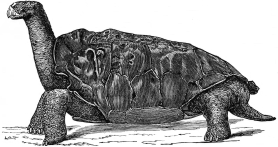
The Crocodiles and their extinct relatives occupy the cases on the left of the entrance from the Bird-gallery and also a stand in the middle of the gallery; and among these may be specially noticed the Indian Gharial, of which both the skeleton and skin are exhibited. The two small cases on each side of the west doorway are occupied by extinct forms and the peculiar Tuatera Lizard of New Zealand. At the south end of the east side are arranged the Turtles and Tortoises, including examples of the Giant Tortoises of the Galapagos (fig. 26) and Mascarene Islands, as well as a large species (Testudo calcarata) from North Africa. Opposite the Turtles and Tortoises58 are the Snakes, among which two large Pythons, coloured to nature, form attractive exhibits. Extinct groups occupy a small case on each side of the east door. Beyond these come the Lizards, which occupy the cases opposite the Crocodiles. The series of Old World Monitor Lizards and American Iguanas is specially noteworthy; and attention may be likewise directed to the curious worm-like Amphisbænas, of which the majority inhabit Tropical America. Casts of remains of the extinct marine Ichthyosaurs and Plesiosaurs are shown in the small cases on the sides of the doorway in the east wall.
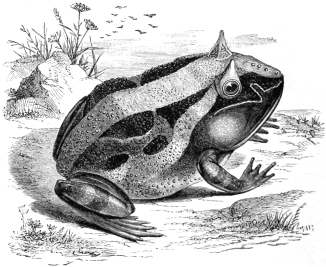
In the Reptile-gallery is placed a large table-case containing a selection of the more important forms of Amphibians, which are divided into such as possess a tail:—Salamanders and Newts; and those without tails:—Frogs and Toads. During some period of their existence most of these animals live in the water, when they breathe by gills, and are in this respect akin to Fishes. The comparatively enormous size attained by certain tropical species of Frogs and Toads, such as the South American Horned Frog (fig. 27), should be noticed.59 The largest representative of the group is the Giant Salamander of Japan and China.
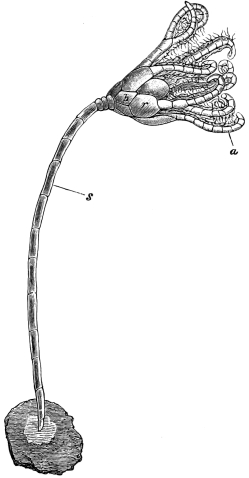
IV. A small gallery is devoted to Starfishes and their allies collectively constituting the class Echinoderma. Specimens of these are arranged systematically in table-cases 1–24; and in case 36 are specimens illustrating the anatomy of the skeleton, and models and figures showing the remarkable changes undergone by these animals in the course of their development. In a separate case on the east side of the gallery is a case containing specimens of a large Starfish to60 illustrate the variability in the number of rays from 4 to 7. In a case on the opposite side is shown Luidia savignei from Mauritius, one of the largest of Starfishes. The Feather-stars (Antedon) are also members of this group; but the most beautiful and remarkable specimens in the gallery are the Sea-Lilies, or Crinoids, collected by the “Challenger” Expedition. One specimen was found attached to an old telegraph-wire taken up in the Caribbean Sea. These deep-sea Crinoids, of which representatives, now extinct, were abundant in earlier periods of the world’s history, are exhibited on tables in the corners of the gallery, by cases 37 and 38. Some of the larval stages of the Feather-stars (fig. 28) resemble stalked Crinoids.
The wall-cases contain representatives of the groups collectively known as Worms. Case 1 contains the Tape-Worms or Cestoda, and the Flukes or Trematoda, the life-history of a species of each being illustrated by specimens, figures, and models. In case 2 the Round-Worms are illustrated by models of Trichina, and the anatomical structure of various other kinds is shown by the aid of diagrams. Case 3 contains specimens of free-living terrestrial and marine Worms, Leeches, and Gephyreans. Case 4 is devoted to specimens of Echinoderms preserved in spirit, especially Holothurians, such as Trepangs or Sea-Cucumbers, the Bêche-de-Mer of the French.
V. A large gallery is devoted to the great group of Shell-fish or Mollusca, the exhibition of which is, however, mainly restricted to their shells. In some cases the form of the soft parts is, however, shown either by specimens in spirit or by means of models.
In wall-cases on the west side of the gallery is a series of shells arranged on tablets to show the leading structural types, such as univalve, bivalve, multivalve, etc.; then the nature of the outer coat, or “skin”; and, thirdly, some of the more striking styles of ornamentation and colouring. Following these, a division is devoted to the display of the general form of the shells of bivalves, special attention being directed to the nature of the hinge by which the two valves are joined. Fresh-water Mussels (Unionidæ) are selected as examples of great variability in the form of the shell in closely allied species.61 Near by is a small series of the shells of boring bivalves, many in the various substances they perforate. Alongside are shown in a similar manner modifications in form and structure presented by Univalve or Gastropod shells; many of the shells having been cut to show their internal structure. Specimens of the horny or shelly plate (operculum) closing the mouth of many Gastropod shells are also exhibited. In one compartment are displayed spirit-preparations of Cephalopod Molluscs, such as Octopus, Cuttle-fish, Squids, Nautilus, Argonaut or Paper-Nautilus, etc. Specimens of the horny beaks possessed by all members of this class are also exhibited; and a Pearly Nautilus (fig. 31), with the shell cut in two in order to show the air-chambers and the comparatively small space occupied by the “animal,” will be found of special interest. From the roof are suspended life-sized models of a Giant Squid (Architenthis) and a Giant Octopus. The Cephalopods were extraordinarily numerous in past ages, and many of the fossil forms are exhibited in the Geological Department.
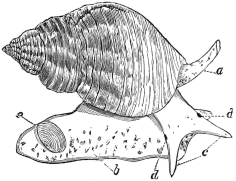
The main shell-collection is contained in four parallel rows of table-cases, the arrangement commencing on the right as the gallery is entered. The first two rows contain the marine forms of Gastropods—a division which includes Snails, Slugs, Whelks (fig. 29), and all those Molluscs which crawl upon the under surface of their bodies; the Cowries, Cones, Volutes, Mitras, and Murexes forming some of the most attractive groups. The two rows of cases on the left contain Land-Shells, Bivalves, and Cephalopods. The Cockles, Oysters, Clams, Piddocks, Teredos,62 Scallops, and Ark-Shells represent some of the principal types of Bivalves, so called on account of their shells being formed of two pieces or valves. A Giant Clam (fig. 30), at the S. end of the gallery, weighs 310 lbs., and measures 36 inches in length.
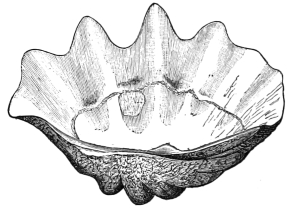
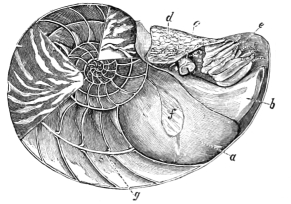
In the same gallery are exhibited examples of three other groups of marine organisms, respectively known as Polyzoa, Brachiopoda, and Tunicata. The Polyzoa live in colonies, and include the so-called Sea-Mat. They are often mistaken for sea-weeds, although in reality they are animals of comparatively high organisation. The Brachiopods have two shells like Bivalve Molluscs, but the valves are dorsal and ventral—that is to say, back and front—instead of right and left. One63 valve is frequently perforated, hence the name of “Lamp-shells,” from a resemblance to an ancient Roman lamp. Sea-squirts, Tunicates, or Ascidians, are worthy of the attention of the visitor on account of their affinity with the Vertebrate stock, of which they may be regarded as a degenerate type. It is in the larvæ or “Ascidian Tadpoles” that the evidence of Vertebrate relationship is most conspicuous, as shown by certain important characters in the nervous system, skeleton, and respiratory organs.
A series of large shells occupies some of the space in the wall-cases, among which attention may be directed to the thick and often handsomely coloured Helmet-shells (Cassis), which, together with the pink Queen-conch (Strombus), were formerly largely used in the now nearly obsolete art of cameo-cutting. In addition to these, a selection of British shells, and series of the eggs of Molluscs, as well as specimens illustrating the formation of pearls, and other points of special interest connected with Molluscs, are displayed. These specimens include not only the Pearl-oyster, but some of the other shells used in the mother-of-pearl trade.
Whale-Room.
Approached by a staircase, leading down from the last (or western-most) of the passages which connect the Bird-gallery with the Coral-gallery, is a separate room in which are placed the specimens of Whales and their relatives. For these, on account of their large size, no other place could be found in the Museum; but the room has, unfortunately, the disadvantage of being too small to display such large animals to full advantage. It is also intersected by columns, which interfere with the complete view of the larger specimens.
As it is almost impracticable to preserve the skins of the larger species of Whales, owing to the oil with which they are saturated, the exhibition of the characters of these animals is carried out by means of their skeletons and artificial models of one side of the body. Complete models, which are much better than actual skins, of many of the smaller kinds, are shown. A general account of the structure and classification of the64 Cetacea, as Whales are technically termed, with reference to those exhibited in this gallery, will be found in a Special Guide.16
On the left side of the entrance is a case containing a stuffed specimen, a skeleton, and several skulls of the Susu, or Fresh-water Dolphin (Platanista gangetica) of the rivers of India, and also of the Dolphins of the Rio de la Plata (Pontoporia blainvillei) and of the River Amazon (Inia geoffroyensis). Among the specimens fronting the visitor as he enters the room, one of the most interesting, on account of its remarkable dentition, is the Narwhal, or Sea-Unicorn. It has only two teeth, which lie horizontally in the upper jaw. In the female both remain permanently concealed within the bone of the jaw, so that this sex is practically toothless; but in the male, while the right tooth remains similarly concealed and rudimentary (as shown in the specimen, by removal of part of the bone which covered it), the left is immensely developed, attaining a length equal to that of half the entire animal, and projecting horizontally from the head in the form of a long, straight, tapering and pointed tusk, spirally grooved on the surface. In rare cases, as in the skull exhibited near the skeleton, both teeth are fully developed, and it is noticeable that in such specimens the direction of the spiral is the same in both tusks.
To the right of the entrance is placed a specimen of the bony framework of one of the most colossal of animals, the Cachalot, or Sperm-Whale (Physeter macrocephalus), fig. 32, prepared from an old male cast ashore near Thurso, on the north coast of Scotland, in July, 1863, on the estate of Captain D. Macdonald, R.E., by whom it was presented to the Museum. Upon one side of this skeleton has been built the model of the external form of the animal. The Sperm-Whale is the principal source of supply of sperm-oil and spermaceti: the former being obtained by boiling the fat or blubber lying beneath the skin over the whole body. The latter, in a liquid state at the ordinary temperature of the living animal, is contained in cells which fill the immense cavity on the top of the skull. This Whale, which feeds chiefly on Cephalopods (Squids and Cuttle-fishes), but also on Fishes, is distributed65 throughout the warm and temperate regions of the Atlantic and Pacific Oceans, and sometimes enters British waters.
In order to render this skeleton more instructive, the names have been attached to the principal bones, thus enabling the visitor to trace at a glance the extraordinary modification from the normal mammalian form the huge skull of this species has undergone.

Most of the largest Cetacea belong to the group called “Whalebone Whales,” in which a series of horny plates termed “whalebone” grow from the palate in place of teeth, and serve to strain the water taken into the mouth from the small marine animals on which these Whales subsist. A representative of this group is the skeleton of the Common Rorqual or Fin-Whale (Balænoptera musculus) in the south-west portion of the room. This Whale, which is sixty-eight feet long, was captured in 1882 in the Moray Firth, Scotland. The flukes of the tail and the back-fin were preserved with the skeleton and are placed above the wall-case behind; the small pelvic bones, and a rudimentary nodule representing the femur or thigh-bone, the only trace of the hind leg of66 this gigantic animal, are also shown. The external form is modelled in plaster. In front is a skeleton and half-model of the Black or North Atlantic Right-Whale (Balæna glacialis or biscayensis). Below this skeleton is placed a lower jaw of the Greenland Right-Whale (Balæna mysticetus), the species which formerly yielded most of the “whalebone” of commerce, and also a miniature wooden model of the entire animal, on the scale of one inch to the foot.
Remains of extinct Cetaceans—notably the solid bony beaks of the skulls of Beaked Whales (Ziphiidæ) from the Red Crag of the east coast of England—are placed in this gallery. A special table-case, near the Sperm-Whale, shows the curious ear-bones of various Cetaceans, both recent and fossil. These bones are perfectly sufficient for the identification of the kind of Whale from which they were taken. In a case on the opposite side of the gallery is displayed the horny wart, termed by sailors the “bonnet,” found on the nose of the Black Right-Whale.
First Floor.
The upper floors of the wings of the Museum consist merely of single galleries extending along the whole front of the building; for the galleries which run backwards on the ground floor form only a single storey.
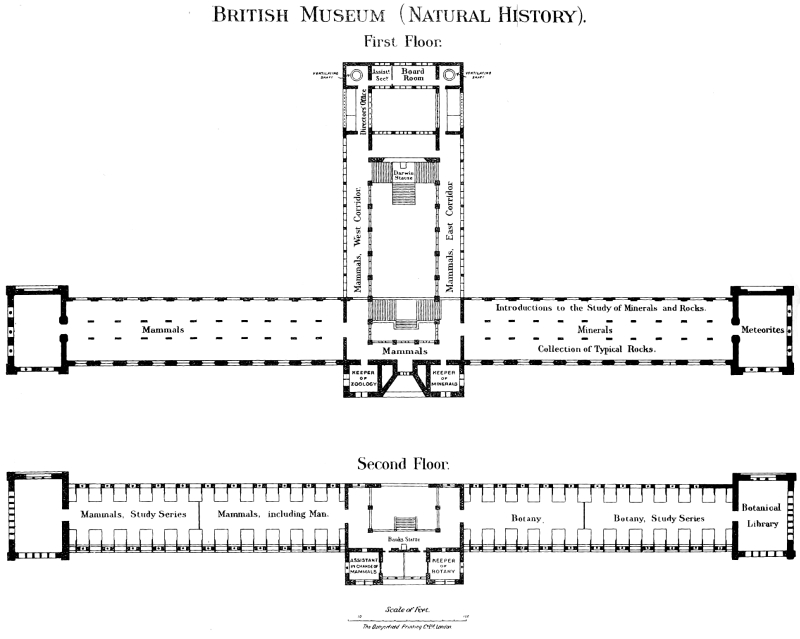
British Museum (Natural History).
First Floor.
Second Floor.
The Lower Mammal-Gallery is entered from the western corridor of the central hall. Together with the adjacent corridor, it contains the greater part of the exhibited series of recent Mammals, with the exception of the Cetacea, Sirenia, and Proboscidea, which are downstairs, and the orders Primates, Chiroptera, Insectivora, and Rodentia, which are in the upper gallery. As three special guides17 are devoted to these galleries, a very brief notice will serve on this occasion. Both stuffed specimens and skulls and skeletons are exhibited, although the former constitute by far the greater portion of the series. A few67 remains of extinct types, or plaster reproductions of the same, are introduced here and there; and photographs of living animals are hung on the walls, where will also be found some instructive series showing the modifications assumed by the teeth of certain groups. Wherever possible, the horns and antlers of the Ruminants, as well as the horns of the Rhinoceroses, are placed in juxtaposition to the animals to which they respectively belong.
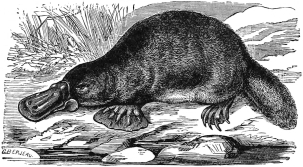
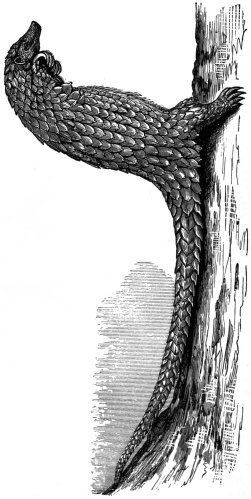
The series commences on the right side of the gallery with the lowest forms. Down the middle is a row of large Mammals, comprising various Deer, Seals, and Rhinoceroses. On the right of the entrance a small case contains the Australian Platypus or Duck-bill (fig. 33) and the Echidnas of Australia and New Guinea, which lay eggs, and are the lowest of all living Mammals. In the adjacent bay are the Marsupials, such as Kangaroos, Phalangers, or so-called Opossums, Wombats, and Bandicoots of Australasia, and the true Opossums of America. The eighth and ninth bays on the left side contain the so-called Edentate Mammals, such as the South American Sloths, Ant-eaters, and Armadillos, the Scaly Ant-eaters or Pangolins (fig. 34) of tropical Asia and Africa, and the African Aard-Vark or Ant-Bear. The Sea-Cows, as represented by the Dugong, the Manatee, and the recently extinct Rhytina of Bering Island, are shown in the Geological Department. In the second bay are the Pigs and Hippopotamuses; in the third the Camels, and near by the68 Chevrotains, or Mouse-Deer. Following these are the Deer (Cervidæ), many of which, as already stated, are placed in the middle line of the gallery. Properly speaking, the Giraffes and69 their recent and extinct allies, the former represented by the Okapi of Central Africa (fig. 14, p. 41), should come here; but, as already mentioned, it has been found convenient to remove the Giraffe group into the east corridor of the central hall. In one of the cases in the bays stands the Prongbuck or Pronghorn Antelope (fig. 35), the sole living representative of a family characterised by the circumstance that the horns have hollow branched sheaths which are shed annually. Next in order come the Antelopes, a large number of which are placed in the corridors outside the gallery. This series, it may be remarked, is particularly fine, and, in fact, unique. At the last two bays on the right side of the gallery the visitor reaches the Goats; and in the “pavilion,” at the west end of the gallery, he comes to the Sheep, Musk-Oxen, and Oxen, of which there is a magnificent display, both as regards mounted specimens and horns. Many of the cases in the middle of the gallery and70 the bays have been fitted with artificial groundwork, one of the most striking being the European Reindeer case, for which the materials were brought from Norway.
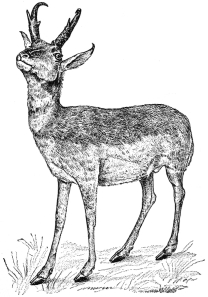
Continuing our survey down the left side of the gallery, the bay next the pavilion and an adjacent case in the middle line contain the Zebras, Wild Asses and the Wild Horse, among which is a specimen of the extinct Quagga. Following this are the Rhinoceroses and Tapirs, some of the former being exhibited in the middle of the gallery. Adult specimens of all the living species except the one-horned Rhinoceros sondaicus of Java are exhibited. The cut (fig. 36) shows the form of the head and the number of the horns in three members of the group.

In a small case by themselves are exhibited the Hyraxes, which represent a subordinal group of Ungulates. In this place should come the Elephants (Proboscidea), but it has been found71 advisable to exhibit the existing species of this group alongside their extinct relatives in the Geological Department, and in the central hall.
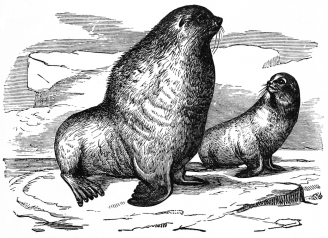
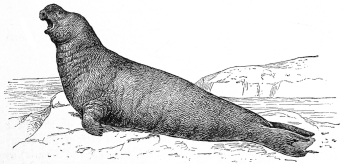
Next in order follow the Seals, Walruses, and Sea-Bears (fig. 37); and after these again, the land Carnivora. Among the former, particular attention may be directed to the specimens of Sea-Elephants or Elephant-Seals (fig. 38) of the Southern72 Seas and the Pacific coast of California. The visitor should also notice the various smaller southern Seals, obtained during the “Discovery” Expedition, in the case in the bay. Among the land Carnivora, special interest attaches to the huge Brown Bear from Alaska, the black and white Bear-like Great Panda (fig. 39) of North-eastern China, and the case of Tigers, in which both the long-haired Manchurian and the short-coated Indian race are shown.
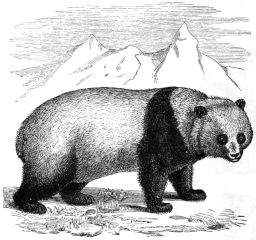
Second Floor.
The portion open to the public of the gallery on this floor in the western wing of the building contains such of the Mammalian orders (apart from Proboscidea, Cetacea, and Sirenia) as are not shown in the lower gallery. In the first two wall-cases on the right on entering the gallery is displayed a series of Bats, some stuffed, and others in spirit. In the third wall-case are the Insect-eating Mammals (Insectivora), such as Shrew-mice, Moles, Hedgehogs, etc. Next come the Rodents,73 and then the Lemurs, Monkeys, and Apes, the greater number of the last being exhibited in the large case in the middle of the gallery. Among the more striking specimens may be mentioned the series of Gorillas (fig. 40) and Chimpanzees, and the Proboscis and Snub-nosed Monkeys.
Nearly all the left side of this gallery is devoted to Anthropology, that is to say, to the representation of the zoological characters of the different races of Mankind18; the series including busts, skeletons, skulls, hair, and portraits.
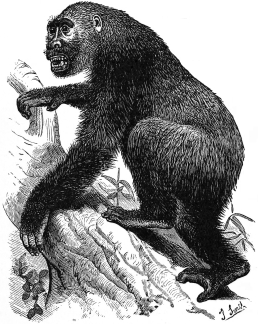
At the west end of the portion of this gallery open to the public stands a case exhibiting many of the structural differences distinguishing the man-like Apes from Man himself;74 and also showing different types of human skulls and the method of measuring the same. On the adjacent screens and partitions are diagrams, photographs, and sketches illustrating hand and finger prints, and identification by means of the latter.
EAST WING.
Ground Floor.
The ground floor of this wing consists, as on the other side of the building, of a gallery running west and east the whole length of the wing in front, of a smaller parallel gallery behind this, and leading from the latter a series of galleries running north and south. With the exception of a certain number of recent skeletons introduced for comparison, and some of the specimens of Elephants and Sirenians or Sea-Cows, the whole of this floor is occupied by the collection of the remains of animals and plants which flourished in geological periods previous to the one in which we are now living. Some of these belong to species still existing upon the earth, but the great majority are extinct. They are arranged mainly upon zoological principles, that is, the groups which are believed to have natural affinities are placed together; but within some of the great divisions thus mapped out, especially of the Invertebrata and Plants, it has been found convenient to adopt a stratigraphical or even geographical grouping, the fossils of different geological formations being kept apart, and those of the British Isles separated from those of foreign localities.
This portion of the Museum is more fully described in the special Guides19 than is possible in the present work.
The front gallery, entered from the central hall, is devoted to Elephants and Sea-Cows, both living and extinct, and to extinct and fossil Mammals of other groups. Down the75 middle are placed a number of large and striking objects, of too great size to be contained in the wall-cases. The first is a nearly complete skeleton of the American Mastodon (fig. 41), an animal closely allied to modern Elephants, from which it is chiefly distinguished by the characters of its cheek-teeth. This is followed by a skeleton of the existing Indian Elephant (Elephas maximus), and the mounted skin of a tuskless male of the same species, brought home from India by His Majesty King Edward VII., when Prince of Wales. Further down the gallery is the skull of the extinct E. ganesa—remarkable for the immense length of its tusks—from the Siwalik Hills of India; and another of the Mammoth (E. primigenius), with huge curved tusks, in a perfect state of preservation, found in the Brick-earth at Ilford, Essex.20 Then follow skeletons of the great extinct Irish Deer (Cervus giganteus), male and female, the former distinguished by its magnificent spreading antlers, resembling those of a Fallow Deer on a large scale.
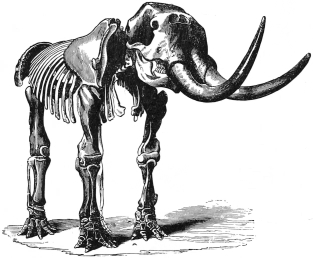
76 The next central case is occupied by the skulls and portions of jaws of a remarkable horned hoofed quadruped, Arsinoïtherium (fig. 42), from the Upper Eocene of the Fayum, Egypt. It belongs to an ancient group not closely related to any living animal.
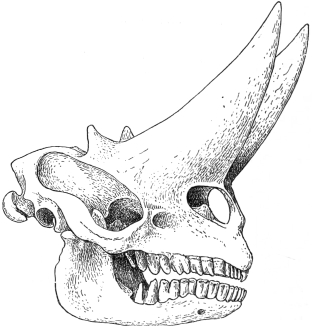
Equally peculiar is the Toxodon (fig. 43) from the Pampas of S. America, of which a model of an entire skeleton is exhibited.
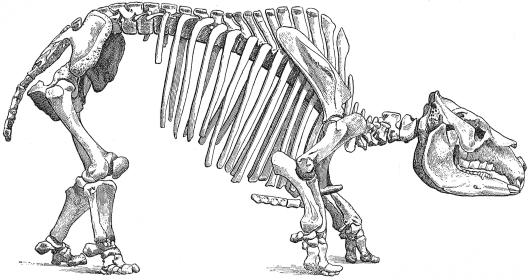
Fig. 43.—Skeleton of the Toxodon (Toxodon platensis).
From the Pampas Formation of Argentina. About 1/18th natural size.
Near by is placed a model of a skeleton of the Dinoceras (fig. 44), one of the most remarkable of the many wonderful forms of animal life discovered in the Tertiary beds of the western portion of the United States of America. This animal combines in some respects the characters of a Rhinoceros with78 those of an Elephant, and has others altogether special to itself. The group to which it belonged became extinct in the Oligocene, or Middle Tertiary, period, without leaving any successors.
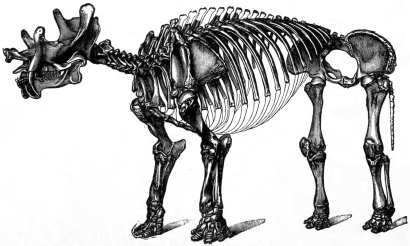
Near the pavilion is a skeleton (fig. 45) of an interesting animal, the Northern Sea-Cow (Rhytina gigas or stelleri), the last resort of which was Bering Island in the North Pacific, where it was completely exterminated towards the close of the eighteenth century. In the same case is placed the skeleton of a smaller allied animal, the Halitherium, from the Oligocene of79 South Germany. These, with their existing representatives, the Manatee and Dugong, constitute the order Sirenia, aquatic Mammals of fish-like form, presenting considerable external resemblance to Cetacea (Whales and Dolphins), but differing in many points of structure and habit. All the exhibited specimens of the group, both living and extinct, are shown in this gallery.
The wall-cases on the south side (right on entering) contain typical series of chipped and polished flint implements of human workmanship, and also remains of Man found, under circumstances which may justify the appellation of “fossil,” in caves or Pleistocene deposits, associated with the bones of Mammals either completely or locally extinct. Then follow in systematic order the bones and teeth of the other Primates, the Carnivora, Ungulata, and Sirenia.

The greater part of the north side of the gallery is devoted to the exhibition of the remains of Proboscidea (Dinotheres, Mastodons, and Elephants), as well as teeth and skulls of the two existing species of Elephants. The forerunners of the Proboscidea from the Eocene strata of Egypt, as represented by Palæomastodon and Mœritherium, are of special interest. Attention may likewise be directed to the skull of the gigantic Ruminant Sivatherium (fig. 46), from the Siwalik deposits of Northern80 India, an ally of the living African Okapi (p. 41), with which it is connected by Helladotherium of the Grecian Tertiary deposits; another still more nearly allied type being Samotherium, from the Isle of Samos, of which a skull (fig. 47) is exhibited.
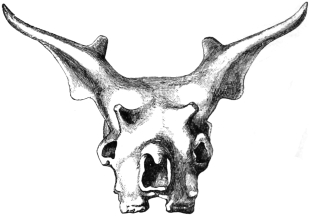
In the “pavilion,” or large room at the end of the gallery, are skeletons and bones of the members of the order Edentata, mostly from South America, including fine specimens of the great Ground-Sloths, the largest of which, the Megatherium, is shown in the act of rearing itself on its hind-legs and powerful tail to seize and tear down the branches of a tree in order to feed upon the leaves. That this was the habit of this huge animal is clearly indicated by the structure of its bones and teeth. The mounted specimen is not an actual skeleton, but is composed of plaster-casts of the real bones, most of which are shown in the wall-case at the north side of the room. Of the Mylodon, a smaller but nearly allied animal, an almost perfect skeleton is exhibited in a glass case near the Megatherium. Near by is a portion of the skin of a closely similar animal (Grypotherium listai), from a cave in Patagonia, showing the hair, and also the nodules of bone embedded in the hide.
Not far off is shown one of the glyptodons, huge extinct81 Armadillo-like animals, of which the body is enclosed in a solid barrel-like bony case. As these animals far surpassed in size their diminutive existing representatives, so the gigantic Marsupials of the corresponding period in Australia (Pleistocene, or latest Tertiary), such as Diprotodon and Nototherium, greatly exceeded any of the species now existing on that continent; of Diprotodon a complete skeleton is exhibited. On the other hand, all the Mammals of the earlier geological periods of which remains are known are of diminutive size, as seen in the series of jaws, teeth, etc., mostly from the Purbeck (Upper Oolite) beds of Dorset and the Stonesfield Slate (Great Oolite) of Oxfordshire, exhibited in the centre window-case on the east side of the room.
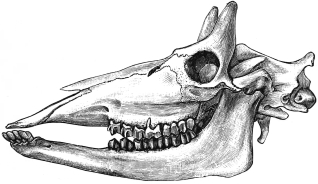
The south side of this room (right on entering) is chiefly reserved for the remains of extinct Birds, including the famous Lizard-tailed Bird (Archæopteryx) of the Solenhofen beds of Bavaria (fig. 48), the oldest known member of the class. Although presenting many Reptile-like characters, it had well-developed feathers on the wings and tail, the impressions of which are beautifully preserved in the specimen. A series of skeletons of the “Moas,” or Dinornithidæ, of New Zealand, birds in which no trace of a wing has been discovered, shows the diversity in size of different members of the group, some83 far exceeding any existing Ostrich, while others are scarcely larger than a good-sized Turkey. Some of these remains are so recent as still to be covered with dried skin, and even feathers. Several eggs are also shown; but, large as these are, they are greatly exceeded in size by those of the Roc (Æpyornis) from Madagascar. The skull and certain other remains of a gigantic extinct bird, Phororhachos, from Patagonia are also shown in this room. These birds appear to have been allied to the existing South American Seriema.
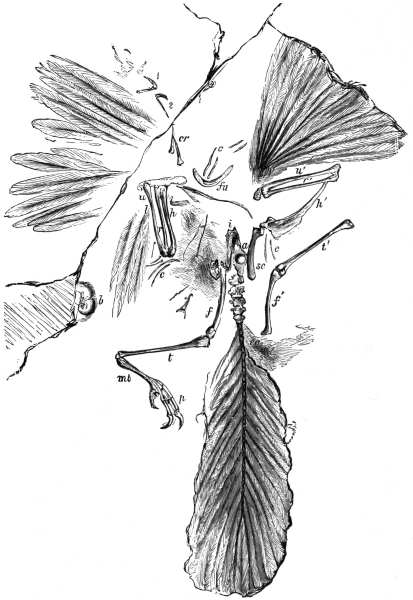
Fig. 48.—Skeleton and Impressions of the Features of the Lizard-tailed Bird (Archæopteryx macrura), from the Upper Jurassic (Lithographic Stone) of Solenhofen, Bavaria. About ¼th natural size.
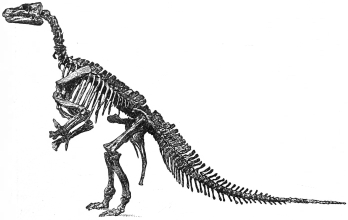
The long corridor north of the fossil Mammal-gallery contains a fine assemblage of Reptilian remains. The south side is devoted to the Great Sea-Lizards (Sauropterygia and Ichthyopterygia), mostly from the Lias formation. The skeleton of an Ichthyosaur from the Lias is shown in fig. 50. Skeletons of Plesiosaurians and Pliosaurians from the Oxford Clay are mounted in central cases. Ranged in the cases on the north side are remains of the gigantic Dinosaurs, which vastly exceeded in size any other land-animals. A mounted plaster cast of a complete skeleton of the Iguanodon (fig. 49), found (with many others) in the Wealden strata at Bernissart in Belgium, is exhibited in the gallery of recent Reptiles; but a large series of bones of the same reptile is shown here.
84
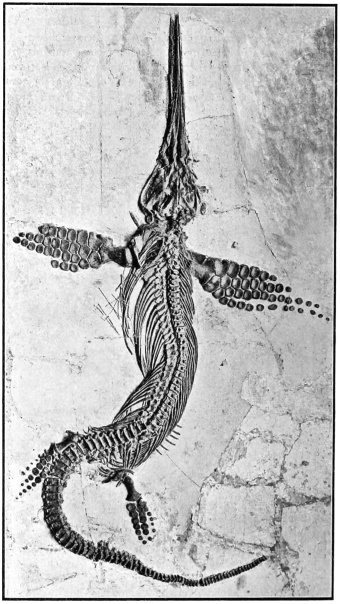
85 In the centre of this gallery is placed a large portion of the skeleton of a gigantic Dinosaur (Cetiosaurus leedsi) from the Upper Jurassic Oxford Clay near Peterborough. It is nearly allied to the North American Diplodocus, of which, as mentioned on page 57, the model of a complete skeleton is exhibited in the recent Reptile Gallery. Both Cetiosaurus and Diplodocus resemble Brontosaurus (fig. 51) in the extremely small size of the skull. Another central case contains an actual skull and other remains of the American Cretaceous horned Dinosaur Triceratops (see page 57), and in wall-case 8 is placed a plaster cast of the skull of the contemporary Tyrannosaurus, the largest known carnivorous Dinosaur.
At the eastern end of the gallery are the Pterosauria or Ornithosauria, commonly called Pterodactyles or Flying Reptiles. Their most gigantic representatives were the species of Pteranodon from the Upper Cretaceous of Kansas (fig. 53). At the west end is the nearly complete skeleton of Pariasaurus (fig. 52) from the Karoo formation (Trias) of South Africa. It occurs also in Russia, and belongs to a primitive section of the Theromorphs, or Anomodonts, which include the ancestors of Mammals.

86
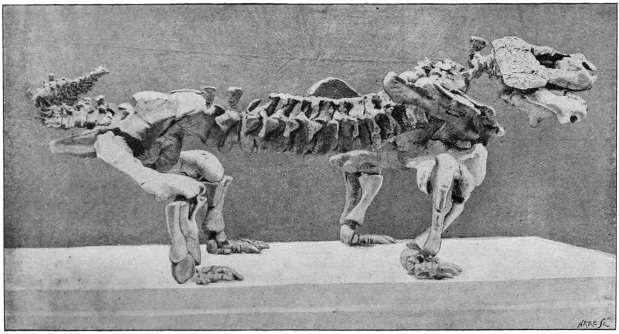
87
Of the galleries running northwards from the Fossil Reptile gallery, the one nearest to the central hall is used for the display of the Fossil Fishes, many belonging to groups now extinct. Perhaps the most remarkable of all, and certainly most unlike existing forms, are the armoured Devonian Fishes known as Cephalaspis, Pterichthys (fig. 54), etc. The well-preserved fishes from the Chalk are especially noteworthy, and a specimen of Portheus in a central case, 14 feet in length, is one of the largest bony fishes known.

Fig. 53.—A Giant Pterodactyle (Pteranodon occidentalis) from the Cretaceous of Kansas. (Original span about 18 feet.) Compare the wing, which is supported by the outermost finger, with that of the Bat in Fig. 8.
The next gallery contains the Cephalopods, a group of Molluscs abounding in extinct species, of which the Belemnites, Turrilites (fig. 55), and Ammonites (fig. 56) are some of the best-known. The form and structure of their nearest living representatives, the various species of Cuttle-fishes, Squids, Argonauts, and Nautilus (fig. 31, page 62) are illustrated by models, drawings, and specimens placed near the entrance of the gallery and along the top-line of the wall-cases. The third gallery contains the remaining Mollusca, with the Brachiopoda, Polyzoa, Echinoderma, Worms, and Crustacea; the fourth, the Corals, Sponges, Protozoa, and Fossil Plants. In these last two galleries most of the British specimens are placed in the table-cases, and those of foreign origin in the cases round the walls.
Among numerous other groups which cannot be mentioned, great interest attaches to the Trilobites (fig. 57) of the Palæozoic epoch, which are related to the modern King-Crabs and also have affinity with the Scorpions.
88 Very extensive is the collection of Fossil Plants from the Coal-Measures, among which Lepidodendron and Sigillaria, as well as numerous kinds of fern-like leaves, are among the most common.
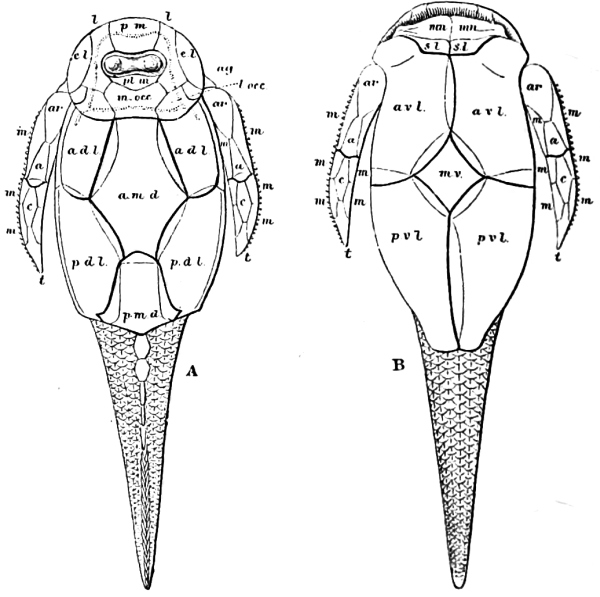
The table-cases of the end gallery contain certain special collections of historical interest, either from the circumstances under which they were formed, or the manner in which they came into possession of the Museum, or from their containing a large number of type specimens described and figured in various publications. Hence it has been considered undesirable to break up and disperse these among the general collection. They include the original collection formed by William Smith, the pioneer of geology in this country, the Searles Wood collection of Crag Mollusca, the Edwards collection of Eocene Mollusca, the Davidson collection of Brachiopoda, the types of Sowerby’s “Mineral Conchology,” and lastly, but not least in interest, specimens from the collection of Sir Hans Sloane, which formed part of the nucleus of the British Museum.
89

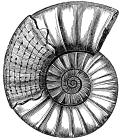
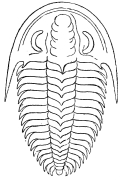
In the wall-cases on the west side of this gallery is exhibited a stratigraphical collection, showing a series of rock-specimens, often with their included fossil remains, representing the various geological formations of the British Isles; they are arranged in the order of their sequence in time, commencing near the entrance door with the most recent, and gradually passing down to the most ancient fossil-bearing strata. Along the top of the case is displayed a running section of all the water-formed rocks of England in the order of their succession, each bed being distinctively coloured, and named to correspond with the actual specimens placed beneath. The stratigraphical collection is followed by some illustrations of rock-formation, and90 certain curious rock-structures simulating fossils. On the east side are exhibited additional specimens of marine Reptiles from the Lias and a series of footprints of Reptiles from the Trias of N. America, the New Red Sandstone of England, etc.
First Floor.
The gallery on this floor, entered from the south end of the east corridor of the hall, contains the extensive Mineral collections, a fuller description of which will be found in special guides.21
Entering the gallery the visitor will find, in the first window-case on the left-hand side, a series of specimens selected and labelled to serve as an introduction to the study of Minerals. Beginning with a definition of what is meant by a Mineral, it shows how essential characters were gradually recognised, and how Minerals are distributed into kinds and classified. In the next three window-cases specimens are arranged to illustrate the characters of Minerals and the various terms used in their description.
In the remaining six window-cases on the same side of the gallery, a corresponding series of specimens illustrative of the characters and classification of Rocks is exhibited; and the eleven window-cases on the opposite side contain a collection illustrating the various kinds of Rocks.22
In the table-cases of the gallery are exhibited specimens of every important Mineral species and variety preserved in the Museum. The cases containing this general collection are numbered from 1 to 41, and the eight panes of each case are severally distinguished by the letters a to h. For the use of the student there is published an Index to the names of all the numerous Mineral species and varieties represented in the collection, with references to the table-cases in which the specimens are placed.23
91 The system of classification, which includes not only ores, but all known Minerals, is not easy for the visitor to follow, and it is therefore convenient to indicate the positions in the gallery of those minerals—as, for instance, precious and ornamental stones, and metallic ores—which have an interest for all; for details, reference must be made to the Mineral Guide. Most of these Minerals occur as crystals, the forms of which can be referred to six systems of crystallisation.
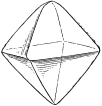
I. In cases 1 and 2 are the native metals, as Copper, Silver, Gold, and Platinum; and non-metals, as Sulphur, Diamond, and Graphite. The large symmetrical South African “Colenso” Diamond (fig. 58), weighing 130 carats, presented by the late Professor John Ruskin, is worthy of special attention (case 1f). Models of some famous diamonds, including “The Cullinan Diamond,” the largest ever found (weight before being cut, 3025¾ carats, or about 1⅓ lb. av.) are exhibited.
II. The next six cases contain Minerals which have mostly a metallic lustre and consist of metals in chemical combination with elements of the Sulphur or Arsenic groups.
Argentite (3d) is an important Silver-ore, containing 87 per cent. of Silver and 13 of Sulphur.
Blende (4b) is a valuable Zinc-ore, and contains 67 per cent. of Zinc and 33 per cent. of Sulphur.
Galena (4e) is by far the most important ore of Lead (Lead 87, Sulphur 13, per cent.).
Copper-glance (3e) is a common ore of Copper (Copper 80, Sulphur 20, per cent.).
Cinnabar (3h) is the ore from which Mercury or Quicksilver is obtained (Mercury 86, Sulphur 14, per cent.).
92 Pyrites (5d), one of the most common of Minerals, is a compound of Iron and Sulphur (Iron 47, Sulphur 53, per cent.).
Erubescite (5e), Copper pyrites (5f), and Tetrahedrite, or Grey Copper-ore (7a), are valuable sources of Copper.
III. Common Salt, the chloride of the metal Sodium, is exhibited in case 8f, and Fluor-spar, a fluoride of Calcium belonging to the same division, begins at case 7e.
IV. The next division consists of compounds of Oxygen and includes most of the stony Minerals.
Cuprite (10a), an important ore of Copper (Copper 89, Oxygen 11, per cent.), is at first ruby-red in colour, but becomes blackened by exposure to light.
Spinel (10e), in its transparent varieties, is one of the precious stones; the deep red being the Spinel Ruby (less dense and less hard than the true Ruby), the rose-tinted the Balas Ruby, and the yellow or orange-red the Rubicelle of the jewellers: sometimes, it has a dark blue colour. On account of their hardness, the less valuable specimens are used for the jewelling of watches.
Magnetite, or Magnetic Iron-ore (10f), the richest ore of Iron, of which it contains 72 per cent., is the natural magnet.
Uraninite, or Pitchblende (10h), consists mainly of Uranium and Oxygen, but contains traces of Helium and Radium, of which latter it is the commercial source.
Chrysoberyl (9e) is another precious stone, almost equal in lustre and hardness to the Sapphire; one variety is a beautiful greenish-yellow; another, with a peculiar play of light, is the Cat’s-eye; and a third, green by sunlight, but red by candle- or lamp-light, is known as Alexandrite.
Corundum (9f), when clear and of the proper colour, is, after the Diamond, the most precious of stones. When pure, it is colourless, but with minute traces of colouring ingredient it assumes the richest and most varied hues; when red it is Ruby, and when blue Sapphire; the yellow, green, and purple varieties were at one time known respectively as the Oriental Topaz, Emerald, and Amethyst. The prefix “Oriental” was at first used to suggest that the stones are not ordinary Topaz, Emerald, and Amethyst, but other similarly coloured93 minerals coming from the East (India, Ceylon, Siam, Pegu, etc.); it was afterwards understood to suggest only the excellence of their characters. The Star-stone, another variety of Corundum, when placed in a strong light shows a six-rayed star.
Hæmatite (11a) is a valuable ore of iron (Iron 70, Oxygen 30, per cent.).
Cassiterite, or Tin-stone (11f), is the ore of Tin, of which metal it contains 79 per cent.
Zircon (13b), when clear and without flaws, is one of the precious stones: one variety with peculiar red tints is the Hyacinth or Jacynth, while the colourless, yellowish, and dull green phases are termed Jargoon: the colourless variety, owing to its high refractive and dispersive power, approaches the Diamond in brilliancy.
Quartz, which is Silica, the oxide of Silicon, is the most common of Minerals. In its clear and transparent variety it is the Crystal of the ancients and the Rock-Crystal of modern times; it is the Brazilian Pebble of spectacle-makers (14c). After the clear come the smoky varieties, including the Scotch Cairngorm and Occidental Topaz (14g). Next follows the Amethyst (14g), one of the less valuable, though one of the most beautiful, of gem stones. The Quartz Cat’s-eye (13f) is a variety presenting a similar play of light to that of the Chrysoberyl Cat’s-eye already referred to: the effect is due to enclosed fibres of an Asbestos-like mineral in the specimens from Ceylon, and to fibres of Crocidolite in the blue, and of altered Crocidolite in the brownish-yellow specimens from South Africa.
Jasper (13g) is a coloured mixture of Silica and Clay, distinguished from ordinary Quartz by its opacity and dull earthy fracture. It is of various colours, chiefly red, brown, yellow, and green; the colours being arranged sometimes in a nodular form, as in Egyptian Jasper, at other times in stripes, as in Riband Jasper.
The Lydian or Touch-stone (15a), by reason of its hardness and black colour, has been used from remote ages to test the purity of precious metals.
Hornstone (15a) is a variety of Silica without evident94 crystallisation, and generally presenting a more or less splintery fracture; in one kind, Flint (15b), the surface of fracture is generally shell-shaped (conchoidal), sometimes conical, as is well shown by specimens in the case.
Chalcedony (15b), which has a lustre nearly that of wax, is translucent. The specimens of Enhydros from Uruguay (15d) are of especial interest as containing imprisoned water.
Heliotrope, or Bloodstone (16a), is a green stone with red, blood-like spots.
Next follow the Plasma and Chrysoprase, which are green stones: and the Sard, generally brownish-red; as also the Sardonyx, its banded variety. All were much prized by the ancients because, though hard and tough enough to resist ordinary wear and tear, they are more suited to the display of the engraver’s skill than the still harder and more precious stones.
Then come the Agates (16b), chiefly formed of thin layers of porous Chalcedony of different colours, though the material of many of the white layers is a compact Semi-opal. Most are now brought from Uruguay, in South America, and cut and polished at Oberstein, in Germany, where in former times Agates were collected in quantity from the mountains of the district. Sometimes the layers are parallel, and the stone is then an Onyx, useful as a material for cameos: or the bands of a section are arranged in parallel sets of zigzag lines, and the stone is then called a Fortification-agate; but in the ordinary agate the layers are variously curved. Moss-agates, or Mocha-stones (16e), are varieties of Chalcedony enclosing moss-like forms of oxides of Manganese and Iron, and green earthy Chlorite. Carnelian (16e) is a beautiful red stone much valued by the engraver: its fracture has a peculiar waxy lustre, and is distinct from that of the Sard, which is dull and horn-like.
Opal, including the Precious or Noble Opal (16f), among the specimens of which is a fine suite from Queensland presented by the late Professor Story-Maskelyne, is hydrated Silica.
Witherite, the carbonate of Barium (18a), is used in the manufacture of plate-glass. Strontianite (18b), the carbonate of Strontium, is one of two minerals from which Strontium95 nitrate is made for use in the manufacture of fireworks, owing to the fine crimson colour which the salt gives to the flame: the Strontium minerals are also employed in connection with sugar-refining. Cerussite (18b) is the corresponding carbonate of Lead, and when abundant is a valuable ore of that metal.
Calcite (18e), a carbonate of the metal Calcium, is represented by a fine suite of specimens, illustrating an almost endless variety of crystalline form. The clear variety from Iceland is largely used in optical instruments for polarising light. Chalybite, or Spathic Iron-ore (20h), is the carbonate of Iron, and a valuable ore of that metal. The most important English Iron-ore, Clay Ironstone, is a mixture of Chalybite and Clay. Calamine (19h), a carbonate of Zinc, is an important Zinc-ore. Chessylite (21d) and Malachite (22b) are respectively the blue and green carbonates of Copper, and are used as ores of that metal. Malachite is found in large masses; by reason of the high polish which it takes and its beautiful markings, it is much used for ornamental work of various kinds.
Passing to the Silicates, we come to Olivine (22f), one of the less hard of the precious stones; when of a yellow colour it is known as Chrysolite, while the green variety is the Peridot of jewellers. Hiddenite (23a) is a rare emerald-green variety of Spodumene, and Kunzite is a lilac-coloured variety which is used as a gem stone.
Asbestos (24c), a kind of Hornblende (a mineral common in rocks of igneous origin), is found in long fibres; in some of its varieties it is so flexible that it can be woven into gloves and other articles. The term Asbestos, meaning unquenched or unquenchable, was applied by the ancient Greeks, because, owing to being unaltered by heat, wicks made of this mineral were used in maintaining the perpetual sacred fires of their temples. Napkins of Asbestos were cleaned by being thrown into the fire; Asbestos-cloth was also used in the process of cremation to keep the ashes of the body distinct from those of the fuel. It is now employed for lining iron-safes, packing for steam-pipes and boilers, and in gas-stoves, for which purposes its low conductivity for heat renders it serviceable.
Jade or Nephrite (24d), a valued mineral, belongs to the96 same group as Hornblende. The various shades of colour and the beautiful polish which this tough mineral will take are illustrated by specimens in the case. Several worked specimens from New Zealand and China are exhibited. An immense water-worn mass, weighing 1156 lb., found some years ago in Asiatic Russia, is mounted on a separate stand near by.
Meerschaum (23g), the light soft porous mineral used for tobacco-pipes, is a hydrated silicate of Magnesium. Serpentine (25a) is another hydrated Magnesium-silicate: the ease with which it is worked and polished, its green colour, and varied markings render it much sought after as a material for mantel-pieces, tables, and other indoor work: exposed to the weather it soon loses its polish.
Topaz (25c) in its clear varieties is one of the precious stones. The crystals from the Urulga river, Siberia, are remarkably fine, and of a delicate brown colour; they are kept covered, as the action of light slowly bleaches them. The yellow crystals from Brazil assume a peculiar pink colour when heated, and are then known to jewellers as Burnt or Pink Topaz. A fine orange-red crystal from Brazil is exhibited.
Garnet also belongs to the group of precious stones; when the red is tinged with violet, the stone is the Almandine or Syrian Garnet (named after Syriam in Pegu), and when cut en cabochon, the Carbuncle of jewellery (26f); the Cinnamon-stone or Hessonite varies in tint from hyacinth-red to honey-yellow (26e); the Pyrope, including the “Cape Ruby” and the Bohemian garnet, is blood-red (26e), Demantoid is an emerald-green (26g).
Jadeite (27a) is one of the green stones which, under the name of Jade, are wrought into ornaments in China: from jade it is distinguished by its chemical composition, structure, and higher specific gravity. Among the specimens of Epidote (27c) a remarkable series from the Untersulzbachthal, Austria, is exhibited.
Mica (28a) is the name given to a group of minerals differing much from each other in chemical composition and optical properties, but having as a common character an easy splitting, or97 cleavage, in a single direction, and thus affording plates remarkably thin, transparent, tough, and elastic. One of these minerals, Muscovite (28d), has been used in Russia in place of glass for windows, and is now in common use for lanterns and stoves, not being so easily cracked as glass by changes of temperature; it is often known in commerce as talc, a term restricted by mineralogists to a different mineral.
The group of Felspars, the most important of the rock-forming minerals, begins at case 28f. After the Felspars comes Beryl, of which the bright green variety, Emerald (29c), is one of the most valued of precious stones. It was in ancient times worked in Egypt, as is proved by specimens found in the old workings by Sir Gardner Wilkinson, and presented by him to the Museum. Emeralds occur in the Urals; but the locality for the finest stones has long been Muzo, about seventy miles from Santa Fé de Bogotá, in South America. Faceted specimens of the colourless Beryl, of the bluish-green Beryl, known in jewellery as Aquamarine, and of pink Beryl from California and Madagascar, are exhibited (30a).
In cases 30f to 32d will be found examples of the Zeolite group of minerals.
Tourmaline (33a), when free from flaws, is, in some of its varieties, to be classed with the precious stones; among these being a pink variety called Rubellite. Fine specimens of Rubellite from Burma, the Urals, and Madagascar, are shown in the case; one specimen from Burma, poor in colour but remarkable for its size and shape, was brought home by Colonel Symes, to whom it had been presented by the King of Ava in the year 1795. The pink-and-green tourmalines from Maine, U.S.A., and the magnificent crystals from San Diego Co., California, are among the more beautiful of the mineral products of the United States. Examples of the blue Tourmaline, or Indicolite, are shown in case 33b.
A rich blue mineral, the Lapis-lazuli of jewellery (34b), brought from Persia, Siberia, Bokhara, and Chili, is a mixture of various species. When powdered, Lapis-lazuli furnished the once costly pigment ultramarine; but by the discovery of a method of producing an artificial and cheap form of the latter, the use of the mineral as a pigment has ceased.
98
The sulphates of Strontium, Celestite (35c), of Barium, Barytes or Heavy Spar (36a), and of Lead, Anglesite (36e), are all represented by series of specimens.
Gypsum, or Selenite (36f), is a hydrated sulphate of the metal Calcium: when heated, it gives up its water of crystallisation and falls to a white powder, known as “Plaster of Paris,” which, when moistened, again combines with water and yields a coherent solid. Gypseous Alabaster, a massive variety of Gypsum (36h), owing to its whiteness, fine texture, and softness is used as a material for statuettes and other indoor ornaments. Oriental Alabaster is a harder substance, Stalagmitic Calcite, carbonate of Calcium.
Borax (37c), a borate of Sodium, is much used as a flux, also in soldering, and in the preparation of easily fusible enamels. It was formerly carried over the Himalayas on sheep and goats from lakes in Tibet, but is now obtained largely from the Borax-lakes of the United States, and is also extensively prepared from the boracic acid lagoons in Tuscany.
Nitratine or Soda-nitre (37d), found in Chili in beds of large extent, is largely used for the preparation of Nitric Acid and Saltpetre, and is also used as a fertiliser.
Calaite or Turquoise (38g), a phosphate of the metals Aluminium and Copper, is generally massive; only very rarely does it occur in the crystalline state. Being as hard as Felspar and taking a good polish, it has been much prized in jewellery; that which comes into the market is chiefly brought from the Turquoise-mines not far from Nishapur, in Persia.
As a supplement to the collection of simple Minerals, is arranged, in case 41, a group of natural substances which either belong or are closely related to the Mineral Kingdom, although, in the formation of most, organised matter has played a very important part. The most important of these are Coal and Amber. Coal (41a), in most of its varieties, gives structural evidence of its vegetable origin: its chemical composition depends on the amount of change which has taken place, and thus is less definite than in the preceding minerals. In the variety called Anthracite all traces of the original organised structure have disappeared. Amber (41c), in ancient99 times regarded as one of the precious stones, is likewise of vegetable origin. It is fossil resin, chiefly derived from trees allied to the pines; its originally sticky condition is proved by the insects sometimes found enclosed.
In the pavilion at the east end of the gallery the visitor will find many mineral specimens which, owing to their size, cannot be satisfactorily exhibited in the table-cases.
Among these, attention may be directed to the magnificent series of Minerals in the wall-cases, and to the large specimen of Gypsum, or Selenite, presented by H.R.H. the late Prince Consort, which, with some fine masses of Iceland Spar, is exhibited in a special case.
Of the four table-cases in the windows of the pavilion, the first three contain a series illustrating the various kinds of Pseudomorphs, or minerals in which the original constituent has been altered and replaced by a new substance which preserves the crystalline form of the first. The fourth displays a set of specimens selected by the late Professor Ruskin to illustrate varieties of Silica.24
The most important feature of the pavilion is the collection of Meteorites,25 of which the smaller specimens are shown in the four central cases. The fall of masses of stone and iron from the sky, though observed again and again since the most remote ages, was very rarely credited by anyone beside the spectators themselves; and till the beginning of the nineteenth century no attempt was made to collect such specimens for examination and comparison. In the special guide it is shown how evidence of the actual fall of such bodies at length became irresistible, and a description is given of the circumstances attending their fall, of their general characters, and their chemical composition: illustrative specimens, collected together for easy reference, will be found in one of the cases. It is also shown that meteorites are closely related, not only to shooting stars, but also to comets, and probably to nebulæ and fixed stars.
100
Second Floor.
The upper floor of the East wing is devoted to the Department of Botany.
The Collections of this Department consist of two portions, the one open to the public and consisting of specimens suitable for exhibition, and mainly intended to illustrate the various groups of the Vegetable Kingdom and the broad facts on which the natural system of the classification of plants is based; the other set apart for the use of persons engaged in the detailed scientific study of plants.
On the landing outside the gallery is a series of tree-sections representing some common British-grown trees, with sections and bark of the Cork-Oak (Quercus suber), and large sections of the White Fir and Douglas Pine from British Columbia. The Douglas Pine was cut down in 1885 when 533 years old; its age is indicated by the annual rings seen in transverse section of the wood, and a record of events has been painted on the surface. A collection of plant-abnormalities is also shown.
The system of classification followed in the exhibition-cases in the public gallery is a modification of one widely used on the Continent and in America. In the first bay on the left-hand side an attempt has been made to illustrate, by means of books dealing with the subject, the history and development of modern systems of classification. There is a Guide26 to this exhibition. The series of specimens (starting on the north, or left-hand, side of the gallery) begins with the simpler orders of Dicotyledonous Seed-plants, those in which petals are wanting in the flower or if present are free from each other, and passes on to the less simple orders with united petals. The orders are represented by dried or otherwise prepared specimens of the plants themselves, drawings, fruits, and prepared sections of the woods. Diagrams are employed to indicate the characters in the flowers on which the grouping is based. The use of the101 same colour for corresponding structures throughout the diagrams readily conveys to the eye the points of agreement or difference on which the classification rests. The geological history of each natural order is indicated on a table of strata, and its present distribution on the surface of the earth given on a small map of the world. Descriptive labels afford particular information respecting each specimen.
The Dicotyledonous Plants extend to the fifth case on the left side of the gallery, and are followed by the Monocotyledonous orders, which fill a portion of the last case on the same side, the two half-cases at the end of the gallery, and the first case returning towards the door. The Gymnosperms are placed in the next case. Then follow the Cryptogams, a case being devoted to the higher, vascular orders, and another to the cellular plants. The series closes with an interesting collection of models of the larger British Fungi, coloured and mounted in accordance with their natural habitats. A Catalogue of these models has been prepared.27 In the table-case in the last bay is placed an illustrated collection of the British Mycetozoa, to which there is also a Guide.28 A large chalk-like mass of Diatom-earth containing twelve billion Diatoms is placed in a case by itself near the entrance to the gallery. The table- and window-cases in the bays contain exhibitions of interest under the following heads: Insectivorous plants (at present in the Central Hall), Parasitic plants, Water-plants, Xerophytic plants, Epiphytic plants, Adaptations for Defence, Climbing plants, Fertilisation of flowers (also in the Hall), and Dispersal of seeds, a selection of British plants dried in sand and preserving their form and colour, and a series of Lichens from Chili. Attention may likewise be directed to a series of coloured drawings of British Plants. At the entrance of the gallery on the right is placed a camera to exhibit stereoscopic views of plants in their natural colours; and on the left is a model of a large fungus (Hydnum).
At the end of the gallery the larger specimens of Palms are set up against the screen dividing the gallery from the Herbarium; other Palms, Cycads, Tree-ferns, etc., are placed in the102 bays next the appropriate wall-cases. Suspended from the roof is a fine specimen of the “Wabo” Bamboo (Dendrocalamus) from Burma, 81 feet long; and on the floor of the gallery are specimens of the Vegetable Sheep (Raoulia) of New Zealand, a large aërial root of a Banyan, a Brazilian Tree-lily (Vellozia), a large Bamboo from Demerara, an Australian Grass-tree (Kingia), a Brazilian Palm (Acrocomia), a Sugar-cane, and a Japanese Cycad.
A collection of British Plants is exhibited in glazed frames fastened by hinges to uprights. The classification of the Flowering Plants and Ferns is that used in Bentham’s “Handbook of the British Flora,” and descriptions are attached as labels to each plant.29 Three series of frames contain specimens of the British Flowering Plants and Ferns. The fourth frame is occupied with the Mosses and Stoneworts (Characeæ), and forms the beginning of the exhibition of Cellular Plants. The series is continued in the frames on the other side of the gallery containing the lower Fungi and coloured drawings of the larger Fungi; a small series of the larger kind of Fungi found near London is also shown. In the first bay to the right on entering are series of coloured drawings (natural size) of edible and poisonous fungi, and of field and cultivated mushrooms and poisonous or worthless species often mistaken for mushrooms. A Guide30 to the latter series has been prepared. The British Lichens are arranged in a cabinet of shallow glass-topped drawers.
Above the entrance to the great Herbarium is a life-size photograph of an Orchid (Phalænopsis) from the Philippine Islands.
The portion reserved for the use of the scientific student consists mainly of the great Herbarium of Flowering Plants. This is a collection of dried plants, respectively fastened on single sheets of stiff folio paper, and representing, so far as it has been possible to obtain them, every species of living plant and the distribution of each of these on the surface of the earth. The various species are collected under their respective genera, which are103 arranged in their natural orders; the whole being classified according to the system of Bentham and Hooker’s “Genera Plantarum.” The plants of the British Isles form a small separate collection. The important herbarium of Sir Hans Sloane is kept distinct in its original form, the plants being pasted on the pages of 333 large folios. There are other ancient herbaria of great historic and scientific interest, as well as an excellent working library and a collection of drawings of plants. The Herbarium of Vascular Cryptogams (Ferns) and Cellular Plants (Mosses, Liverworts, Algæ, Lichens, and Fungi) is in a separate room entered from the head of the great staircase.

